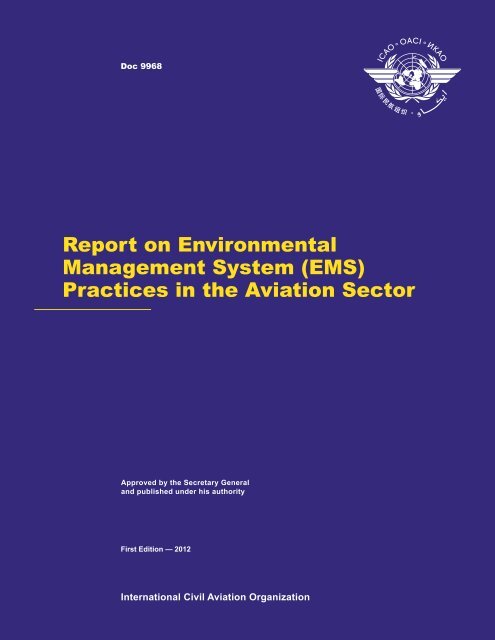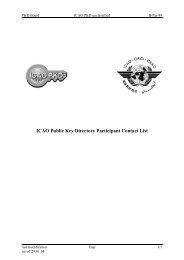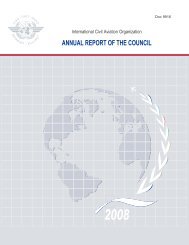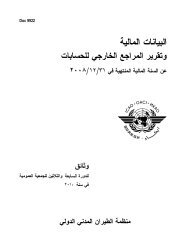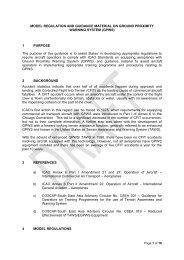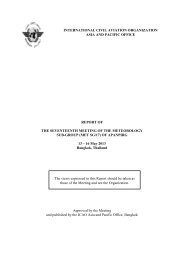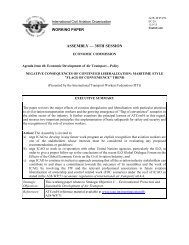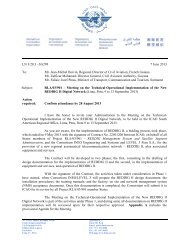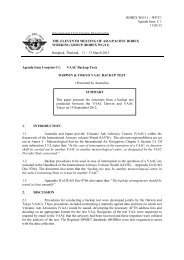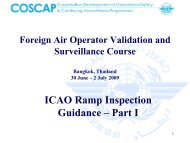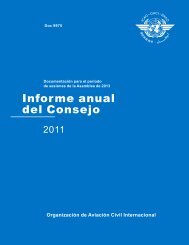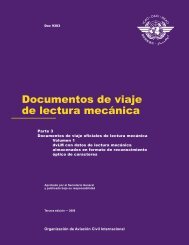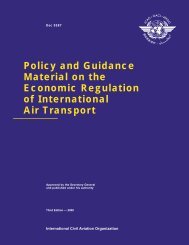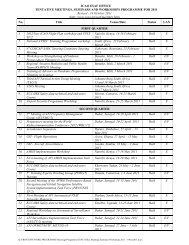Report on Environmental Management System (EMS ... - ICAO
Report on Environmental Management System (EMS ... - ICAO
Report on Environmental Management System (EMS ... - ICAO
Create successful ePaper yourself
Turn your PDF publications into a flip-book with our unique Google optimized e-Paper software.
Doc 9968<br />
<str<strong>on</strong>g>Report</str<strong>on</strong>g> <strong>on</strong> Envir<strong>on</strong>mental<br />
<strong>Management</strong> <strong>System</strong> (<strong>EMS</strong>)<br />
Practices in the Aviati<strong>on</strong> Sector<br />
Approved by the Secretary General<br />
and published under his authority<br />
First Editi<strong>on</strong> — 2012<br />
Internati<strong>on</strong>al Civil Aviati<strong>on</strong> Organizati<strong>on</strong>
Doc 9968<br />
<str<strong>on</strong>g>Report</str<strong>on</strong>g> <strong>on</strong> Envir<strong>on</strong>mental<br />
<strong>Management</strong> <strong>System</strong> (<strong>EMS</strong>)<br />
Practices in the Aviati<strong>on</strong> Sector<br />
________________________________<br />
Approved by the Secretary General<br />
and published under his authority<br />
First Editi<strong>on</strong> — 2012<br />
Internati<strong>on</strong>al Civil Aviati<strong>on</strong> Organizati<strong>on</strong>
Published in separate English, Arabic, Chinese, French, Russian<br />
and Spanish editi<strong>on</strong>s by the<br />
INTERNATIONAL CIVIL AVIATION ORGANIZATION<br />
999 University Street, M<strong>on</strong>tréal, Quebec, Canada H3C 5H7<br />
For ordering informati<strong>on</strong> and for a complete listing of sales agents<br />
and booksellers, please go to the <strong>ICAO</strong> website at www.icao.int<br />
Doc 9968, <str<strong>on</strong>g>Report</str<strong>on</strong>g> <strong>on</strong> Envir<strong>on</strong>mental <strong>Management</strong> <strong>System</strong> (<strong>EMS</strong>)<br />
Practices in the Aviati<strong>on</strong> Sector<br />
Order Number: 9968<br />
ISBN 978-92-9231-834-5<br />
© <strong>ICAO</strong> 2012<br />
All rights reserved. No part of this publicati<strong>on</strong> may be reproduced, stored in a<br />
retrieval system or transmitted in any form or by any means, without prior<br />
permissi<strong>on</strong> in writing from the Internati<strong>on</strong>al Civil Aviati<strong>on</strong> Organizati<strong>on</strong>.
AMENDMENTS<br />
Amendments are announced in the supplements to the Catalogue of <strong>ICAO</strong><br />
Publicati<strong>on</strong>s; the Catalogue and its supplements are available <strong>on</strong> the <strong>ICAO</strong><br />
website at www.icao.int. The space below is provided to keep a record of<br />
such amendments.<br />
RECORD OF AMENDMENTS AND CORRIGENDA<br />
AMENDMENTS CORRIGENDA<br />
No. Date Entered by No. Date Entered by<br />
(iii)
TABLE OF CONTENTS<br />
Executive summary .............................................................................................................................................. (vii)<br />
Acr<strong>on</strong>yms .............................................................................................................................................................. (ix)<br />
Chapter 1. Introducti<strong>on</strong> ..................................................................................................................................... 1-1<br />
1.1. Background ............................................................................................................................................ 1-1<br />
1.2. Methodology .......................................................................................................................................... 1-2<br />
1.3. Questi<strong>on</strong>naire data ................................................................................................................................ 1-3<br />
1.4. Introducti<strong>on</strong> to <strong>EMS</strong> ............................................................................................................................... 1-4<br />
Chapter 2. Questi<strong>on</strong>naire participati<strong>on</strong> ........................................................................................................... 2-1<br />
2.1. Introducti<strong>on</strong> ............................................................................................................................................ 2-1<br />
2.2. Sector characterizati<strong>on</strong> .......................................................................................................................... 2-1<br />
Chapter 3. Envir<strong>on</strong>mental management drivers ............................................................................................. 3-1<br />
3.1. Introducti<strong>on</strong> ............................................................................................................................................ 3-1<br />
3.2. Priority envir<strong>on</strong>mental issues or impacts ................................................................................................ 3-1<br />
Chapter 4. Approaches to envir<strong>on</strong>mental management ................................................................................ 4-1<br />
4.1. Introducti<strong>on</strong> ............................................................................................................................................ 4-1<br />
4.2. Applicati<strong>on</strong> of <strong>EMS</strong> standards or guidelines ........................................................................................... 4-1<br />
4.3. Scope of <strong>EMS</strong> ........................................................................................................................................ 4-3<br />
4.4. Other management systems in place .................................................................................................... 4-4<br />
Chapter 5. Performance m<strong>on</strong>itoring and communicati<strong>on</strong> .............................................................................. 5-1<br />
5.1. Introducti<strong>on</strong> ............................................................................................................................................ 5-1<br />
5.2. Performance m<strong>on</strong>itoring ......................................................................................................................... 5-1<br />
5.3. Communicati<strong>on</strong> methods ....................................................................................................................... 5-2<br />
(v)<br />
Page
<str<strong>on</strong>g>Report</str<strong>on</strong>g> <strong>on</strong> Envir<strong>on</strong>mental <strong>Management</strong><br />
(vi) <strong>System</strong> Practices in the Aviati<strong>on</strong> Sector<br />
Chapter 6. Implementati<strong>on</strong> and maintenance ................................................................................................. 6-1<br />
6.1. Introducti<strong>on</strong> ............................................................................................................................................ 6-1<br />
6.2. <strong>EMS</strong> implementati<strong>on</strong> .............................................................................................................................. 6-1<br />
6.3. <strong>EMS</strong> maintenance ................................................................................................................................. 6-4<br />
Chapter 7. Benefits and challenges ................................................................................................................. 7-1<br />
7.1. Introducti<strong>on</strong> ............................................................................................................................................ 7-1<br />
7.2. Implementati<strong>on</strong> challenges .................................................................................................................... 7-1<br />
7.3. Benefits of <strong>EMS</strong> implementati<strong>on</strong> ............................................................................................................ 7-1<br />
7.4. Trade-off analysis .................................................................................................................................. 7-1<br />
Chapter 8. Organizati<strong>on</strong>s without an <strong>EMS</strong>....................................................................................................... 8-1<br />
8.1. Introducti<strong>on</strong> ............................................................................................................................................ 8-1<br />
8.2. Envir<strong>on</strong>mental programme elements or principles ................................................................................. 8-1<br />
8.3. Performance m<strong>on</strong>itoring ......................................................................................................................... 8-4<br />
8.4. Communicati<strong>on</strong> methods ....................................................................................................................... 8-9<br />
8.5. <strong>EMS</strong> applicati<strong>on</strong> and development issues ............................................................................................. 8-10<br />
Chapter 9. Recommendati<strong>on</strong>s .......................................................................................................................... 9-1<br />
Chapter 10. C<strong>on</strong>clusi<strong>on</strong> .................................................................................................................................... 10-1<br />
Appendix. References ....................................................................................................................................... A-1<br />
_____________________<br />
Page
EXECUTIVE SUMMARY<br />
Pressure <strong>on</strong> the aviati<strong>on</strong> industry to balance increasing global demands in air travel with envir<strong>on</strong>mental protecti<strong>on</strong> is at<br />
an all time high. Therefore, an effective approach to sustain operati<strong>on</strong>s and meet future envir<strong>on</strong>mental requirements is<br />
critical. The Internati<strong>on</strong>al Civil Aviati<strong>on</strong> Organizati<strong>on</strong>’s (<strong>ICAO</strong>’s) Committee <strong>on</strong> Aviati<strong>on</strong> Envir<strong>on</strong>mental Protecti<strong>on</strong> (CAEP)<br />
is the internati<strong>on</strong>al forum of expertise for the study and development of proposals to minimize the impact of aviati<strong>on</strong> <strong>on</strong><br />
the envir<strong>on</strong>ment.<br />
At the seventh meeting of CAEP (CAEP/7) in February 2007, the Land Use Planning and Noise <strong>Management</strong> Task<br />
Group (TG) was asked to deliver a report at the eighth meeting of CAEP (CAEP/8) in February 2010 <strong>on</strong> the use of<br />
envir<strong>on</strong>mental management systems (<strong>EMS</strong>s) and, as appropriate, make recommendati<strong>on</strong>s <strong>on</strong> how the committee could<br />
promote the use of <strong>EMS</strong> within the aviati<strong>on</strong> system. In resp<strong>on</strong>se, the TG developed an industry questi<strong>on</strong>naire to learn<br />
more about the applicati<strong>on</strong> and potential value of <strong>EMS</strong> to aviati<strong>on</strong> organizati<strong>on</strong>s. The questi<strong>on</strong>naire and accompanying<br />
State letter were distributed worldwide by Member States and internati<strong>on</strong>al representative organizati<strong>on</strong>s in May 2008.<br />
Approximately 326 organizati<strong>on</strong>s resp<strong>on</strong>ded to the questi<strong>on</strong>naire and were categorized into five different sectors,<br />
including air navigati<strong>on</strong> services providers (ANSPs), airlines, airports, manufacturers and other aviati<strong>on</strong> organizati<strong>on</strong>s.<br />
After validating the data, informati<strong>on</strong> from 233 resp<strong>on</strong>ses formed the basis of this report to CAEP/8 and supported the<br />
development of recommendati<strong>on</strong>s.<br />
Approximately 50 per cent of questi<strong>on</strong>naire resp<strong>on</strong>dents (117) applied <strong>EMS</strong> standards or guidelines, with the majority<br />
having an ISO 14001:2004 certified <strong>EMS</strong> in place. The remaining 116 resp<strong>on</strong>dents had other envir<strong>on</strong>mental<br />
programmes with many of the same principles and practices that are required as part of a formal <strong>EMS</strong>. For those<br />
organizati<strong>on</strong>s with an <strong>EMS</strong>, 82 per cent had additi<strong>on</strong>al management systems—approximately 51 per cent of these<br />
additi<strong>on</strong>al systems were integrated or coordinated with the organizati<strong>on</strong>’s <strong>EMS</strong>. Over the past ten years, <strong>EMS</strong><br />
implementati<strong>on</strong> has been relatively c<strong>on</strong>sistent in the aviati<strong>on</strong> industry. Resp<strong>on</strong>dents indicated that 6 to 12 m<strong>on</strong>ths <strong>on</strong><br />
average were needed to successfully develop and implement an <strong>EMS</strong>. Approximately 71 per cent had assistance with<br />
<strong>EMS</strong> implementati<strong>on</strong> from a c<strong>on</strong>sulting or c<strong>on</strong>tracting firm.<br />
Regardless of whether the resp<strong>on</strong>dent organizati<strong>on</strong> had an <strong>EMS</strong>, measuring envir<strong>on</strong>mental performance was important<br />
for ensuring compliance. On average, the majority of resp<strong>on</strong>dents communicated envir<strong>on</strong>mental performance through a<br />
corporate social resp<strong>on</strong>sibility (CSR) report or through their organizati<strong>on</strong>’s website. Seventy-nine resp<strong>on</strong>dent<br />
organizati<strong>on</strong>s without an <strong>EMS</strong> plan to implement <strong>on</strong>e in the future. Their most comm<strong>on</strong> reas<strong>on</strong> for not implementing an<br />
<strong>EMS</strong> was unfamiliarity with <strong>EMS</strong> approaches, and as a result, they requested aviati<strong>on</strong> industry specific <strong>EMS</strong><br />
implementati<strong>on</strong> guidance.<br />
The informati<strong>on</strong> provided by resp<strong>on</strong>dents formed the basis of two recommendati<strong>on</strong>s which focused <strong>on</strong> increasing<br />
awareness of <strong>EMS</strong> principles and best practices in the aviati<strong>on</strong> sector and establishing practical guidance to assist those<br />
organizati<strong>on</strong>s that choose to use <strong>EMS</strong> to enhance their management of envir<strong>on</strong>mental issues. Awareness and guidance<br />
materials should integrate existing <strong>ICAO</strong> envir<strong>on</strong>mental tools, guidelines and manuals. Where possible, they should<br />
encourage organizati<strong>on</strong>s to support higher-level <strong>ICAO</strong> envir<strong>on</strong>mental objectives, c<strong>on</strong>sider the collaborative nature of the<br />
aviati<strong>on</strong> industry, and account for variance in operati<strong>on</strong> type (i.e. sector type) and the level of <strong>EMS</strong> maturity at the<br />
organizati<strong>on</strong>.<br />
(vii)
<str<strong>on</strong>g>Report</str<strong>on</strong>g> <strong>on</strong> Envir<strong>on</strong>mental <strong>Management</strong><br />
(viii) <strong>System</strong> Practices in the Aviati<strong>on</strong> Sector<br />
Recommendati<strong>on</strong>s<br />
Disseminate report informati<strong>on</strong>. Within the first year of the CAEP/9 cycle, <strong>ICAO</strong> should make the informati<strong>on</strong><br />
c<strong>on</strong>tained in this report publicly available. A report should be distributed specifically to CAEP States and observers<br />
and to all survey resp<strong>on</strong>dents.<br />
Develop <strong>EMS</strong> guidance. Stand-al<strong>on</strong>e <strong>EMS</strong> guidance should be developed for the end of the CAEP/9 cycle to assist<br />
organizati<strong>on</strong>s to determine how <strong>EMS</strong> elements and principles can be used to enhance the way they manage<br />
envir<strong>on</strong>mental issues, and provide practical guidance <strong>on</strong> how these <strong>EMS</strong> elements and principles can be<br />
implemented/integrated into existing management systems and business processes.<br />
_____________________
ACRONYMS<br />
ACI Airports Council Internati<strong>on</strong>al<br />
ANSP Air navigati<strong>on</strong> services provider<br />
CAEP Committee <strong>on</strong> Aviati<strong>on</strong> Envir<strong>on</strong>mental Protecti<strong>on</strong><br />
CSR Corporate social resp<strong>on</strong>sibility<br />
CANSO Civil Air Navigati<strong>on</strong> Services Organisati<strong>on</strong><br />
EMAS Eco-management audit scheme<br />
<strong>EMS</strong> Envir<strong>on</strong>mental management system<br />
FAA Federal Aviati<strong>on</strong> Administrati<strong>on</strong><br />
IATA Internati<strong>on</strong>al Air Transport Associati<strong>on</strong><br />
ICCAIA Internati<strong>on</strong>al Coordinating Council of Aerospace Industries Associati<strong>on</strong>s<br />
ISO Internati<strong>on</strong>al Organizati<strong>on</strong> for Standardizati<strong>on</strong><br />
O&M Operati<strong>on</strong> and maintenance<br />
SMS Safety management system<br />
TG Task group<br />
QMS Quality management system<br />
Abbreviati<strong>on</strong><br />
USD United States dollar<br />
______________________<br />
(ix)
Chapter 1<br />
INTRODUCTION<br />
1.1 BACKGROUND<br />
1.1.1 Global demand for air travel is estimated to increase significantly in the future. While the benefits of this<br />
growth will be substantial, it is likely to be accompanied by an increase in aviati<strong>on</strong>-related envir<strong>on</strong>mental impacts. Local<br />
air quality, ambient noise levels, water quality, energy use and climate change are some of the most prominent impacts<br />
of c<strong>on</strong>cern. Pressure <strong>on</strong> the aviati<strong>on</strong> industry to balance increasing demand with envir<strong>on</strong>mental protecti<strong>on</strong> is at an<br />
all-time high. Therefore, an effective approach to sustain operati<strong>on</strong>s and meet future envir<strong>on</strong>mental requirements is<br />
critical. Identifying the significant envir<strong>on</strong>mental impacts of aviati<strong>on</strong> and effectively managing these impacts efficiently<br />
through the use of technology, procedures and policy is likely to play an important role in the sustainable growth of the<br />
aviati<strong>on</strong> industry.<br />
<strong>ICAO</strong> and the envir<strong>on</strong>ment<br />
1.1.2 <strong>ICAO</strong> is a specialized agency of the United Nati<strong>on</strong>s created in 1944 to promote the safe and orderly<br />
development of global air transport. <strong>ICAO</strong>’s work <strong>on</strong> the envir<strong>on</strong>ment focuses primarily <strong>on</strong> those problems that benefit<br />
most from a comm<strong>on</strong> and coordinated approach <strong>on</strong> a worldwide basis, namely, aircraft noise and engine emissi<strong>on</strong>s. The<br />
following envir<strong>on</strong>mental goals have been established by <strong>ICAO</strong>:<br />
a) limit or reduce the number of people affected by significant aircraft noise;<br />
b) limit or reduce the adverse impact of aviati<strong>on</strong> emissi<strong>on</strong>s <strong>on</strong> local air quality; and<br />
c) limit or reduce the impact of aviati<strong>on</strong> greenhouse gas emissi<strong>on</strong>s <strong>on</strong> the global climate.<br />
1.1.3 <strong>ICAO</strong>’s Committee <strong>on</strong> Aviati<strong>on</strong> Envir<strong>on</strong>mental Protecti<strong>on</strong> (CAEP) is the internati<strong>on</strong>al forum of expertise for<br />
the study and development of proposals to minimize the impact of aviati<strong>on</strong> <strong>on</strong> the envir<strong>on</strong>ment. Its membership c<strong>on</strong>sists<br />
of experts from <strong>ICAO</strong> Member States and observer organizati<strong>on</strong>s, including intergovernmental and n<strong>on</strong>-governmental<br />
organizati<strong>on</strong>s representing the aviati<strong>on</strong> industry and envir<strong>on</strong>mental interests. CAEP is resp<strong>on</strong>sible for c<strong>on</strong>ducting studies<br />
and recommending measures to minimize and reduce aviati<strong>on</strong>’s impact <strong>on</strong> the envir<strong>on</strong>ment, and for maintaining<br />
certificati<strong>on</strong> Standards for aircraft noise and aircraft engine emissi<strong>on</strong>s. Recommendati<strong>on</strong>s made by CAEP are reviewed<br />
and adopted by the <strong>ICAO</strong> Council. The Council reports to the <strong>ICAO</strong> Assembly where the main policies <strong>on</strong> aviati<strong>on</strong><br />
envir<strong>on</strong>mental protecti<strong>on</strong> are defined and translated into Assembly Resoluti<strong>on</strong>s.<br />
1.1.4 Since its creati<strong>on</strong> in 1983, the role of CAEP has progressively expanded from <strong>on</strong>e of setting basic<br />
standards to the development of broad policy measures, such as the balanced approach to limit or reduce the impact of<br />
aircraft noise, and the creati<strong>on</strong> of market-based measures to handle noise and emissi<strong>on</strong>s charges and emissi<strong>on</strong>s trading.<br />
In order to achieve a greater understanding of the envir<strong>on</strong>mental impacts of aviati<strong>on</strong>, CAEP encourages research<br />
through the collecti<strong>on</strong>, generati<strong>on</strong>, analysis, harm<strong>on</strong>izati<strong>on</strong>, exchange, and disseminati<strong>on</strong> of informati<strong>on</strong> related to<br />
aviati<strong>on</strong> envir<strong>on</strong>mental issues. CAEP’s work often results in published reports, guidance material, and/or specific studies.<br />
1-1
<str<strong>on</strong>g>Report</str<strong>on</strong>g> <strong>on</strong> Envir<strong>on</strong>mental <strong>Management</strong><br />
1-2 <strong>System</strong> (<strong>EMS</strong>) Practices in the Aviati<strong>on</strong> Sector<br />
CAEP/8 <strong>EMS</strong> task<br />
1.1.5 An envir<strong>on</strong>mental management system (<strong>EMS</strong>) provides a methodology and framework to systemically<br />
identify and cost-effectively manage significant envir<strong>on</strong>mental aspects of aviati<strong>on</strong> organizati<strong>on</strong>s’ operati<strong>on</strong>s and have<br />
proven effective across a wide range of organizati<strong>on</strong>s, including airports, air carriers, manufacturers and government<br />
agencies. As a result, internati<strong>on</strong>al recogniti<strong>on</strong> of the potential value of <strong>EMS</strong> as a tool to help aviati<strong>on</strong> organizati<strong>on</strong>s<br />
manage their envir<strong>on</strong>mental issues is increasing. <strong>ICAO</strong> wanted to further understand the applicati<strong>on</strong> of <strong>EMS</strong> by aviati<strong>on</strong><br />
organizati<strong>on</strong>s, encourage implementati<strong>on</strong> to help them overcome envir<strong>on</strong>mental challenges and better use<br />
envir<strong>on</strong>mental opportunities.<br />
1.1.6 At the seventh meeting of CAEP (CAEP/7) in February 2007, the Land Use Planning and Noise<br />
<strong>Management</strong> Task Group (TG) was asked to deliver a report to the eighth meeting of CAEP (CAEP/8) in February 2010<br />
providing informati<strong>on</strong> <strong>on</strong> the use of <strong>EMS</strong> and, as appropriate, make recommendati<strong>on</strong>s <strong>on</strong> how the committee could<br />
promote the use of <strong>EMS</strong> within the aviati<strong>on</strong> system. In resp<strong>on</strong>se, the TG formed an ad hoc working group to perform the<br />
task and proposed a questi<strong>on</strong>naire to gather informati<strong>on</strong> for the report. The United States Federal Aviati<strong>on</strong><br />
Administrati<strong>on</strong> (FAA) agreed to lead the effort, and an ad hoc working group was formed with representatives from<br />
Transport Canada, Italy, Internati<strong>on</strong>al Coordinating Council of Aerospace Industries Associati<strong>on</strong>s (ICCAIA), Internati<strong>on</strong>al<br />
Air Transport Associati<strong>on</strong> (IATA) and Airports Council Internati<strong>on</strong>al (ACI).<br />
1.1.7 The CAEP/8 <strong>EMS</strong> task was to:<br />
a) deliver a report providing informati<strong>on</strong> <strong>on</strong> the use of <strong>EMS</strong> am<strong>on</strong>g airports, airlines and air navigati<strong>on</strong><br />
providers in order to give a base of understanding in the aviati<strong>on</strong> sector; and<br />
b) based <strong>on</strong> the report, as appropriate, make recommendati<strong>on</strong>s <strong>on</strong> how the committee could promote the<br />
use of <strong>EMS</strong> within the aviati<strong>on</strong> sector.<br />
1.2 METHODOLOGY<br />
1.2.1 The TG developed an industry questi<strong>on</strong>naire based widely <strong>on</strong> input from members of the working group to<br />
gain an understanding of envir<strong>on</strong>mental management practices in the aviati<strong>on</strong> sector. This questi<strong>on</strong>naire was divided<br />
into eight secti<strong>on</strong>s that sought understand the resp<strong>on</strong>ding organizati<strong>on</strong>s and their envir<strong>on</strong>mental management practices<br />
by inquiring about the following:<br />
a) envir<strong>on</strong>mental management drivers;<br />
b) approach to envir<strong>on</strong>mental management;<br />
c) performance m<strong>on</strong>itoring and communicati<strong>on</strong> methods;<br />
d) resources required for implementati<strong>on</strong> and maintenance; and<br />
e) less<strong>on</strong>s learned.
Chapter 1. Introducti<strong>on</strong> 1-3<br />
1.2.2 The questi<strong>on</strong>naire and accompanying State letter were approved by the <strong>ICAO</strong> Secretary General <strong>on</strong><br />
16 May 2008 and distributed worldwide by Member States and *internati<strong>on</strong>al representative organizati<strong>on</strong>s.<br />
Approximately 326 organizati<strong>on</strong>s resp<strong>on</strong>ded to the questi<strong>on</strong>naire over a six-m<strong>on</strong>th period.<br />
1.2.3 Following validati<strong>on</strong>, individual sector data were forwarded to the appropriate internati<strong>on</strong>al representative<br />
organizati<strong>on</strong> so a summary analysis could be c<strong>on</strong>ducted to characterize the resp<strong>on</strong>dents in a given sector. After the<br />
resp<strong>on</strong>se data were validated and characterized, data from the remaining 233 resp<strong>on</strong>ses were analysed and formed the<br />
basis of the report to CAEP/8.<br />
1.3 QUESTIONNAIRE DATA<br />
1.3.1 As a result of the number and range of organizati<strong>on</strong>s from different States that resp<strong>on</strong>ded to the<br />
questi<strong>on</strong>naire, variati<strong>on</strong> in the data exists. Comm<strong>on</strong> inc<strong>on</strong>sistencies included the submissi<strong>on</strong> of partially completed<br />
surveys; multiple different resp<strong>on</strong>ses from the same organizati<strong>on</strong>; and resp<strong>on</strong>ses to both questi<strong>on</strong> sets, i.e. those for<br />
organizati<strong>on</strong>s with an <strong>EMS</strong> and those for organizati<strong>on</strong>s without an <strong>EMS</strong>. It was critical that the data be as c<strong>on</strong>sistent as<br />
possible for a str<strong>on</strong>g informative analysis. Therefore, the TG developed resoluti<strong>on</strong>s <strong>on</strong> how comm<strong>on</strong> inc<strong>on</strong>sistencies<br />
should be addressed prior to analysis as follows:<br />
a) delete those resp<strong>on</strong>ses from the data set that provided no informati<strong>on</strong> <strong>on</strong> the organizati<strong>on</strong>’s<br />
envir<strong>on</strong>mental management practices;<br />
b) delete those resp<strong>on</strong>ses from the data set that were duplicate;<br />
c) request clarificati<strong>on</strong> from internati<strong>on</strong>al representative organizati<strong>on</strong>s for resp<strong>on</strong>ses that were from the<br />
same organizati<strong>on</strong> but not duplicate;<br />
d) review data specifically by sector to see what can be d<strong>on</strong>e about inc<strong>on</strong>sistent financial figures;<br />
e) request clarificati<strong>on</strong> from the internati<strong>on</strong>al representative organizati<strong>on</strong>s or resp<strong>on</strong>dents for those<br />
resp<strong>on</strong>ses that claimed they do not apply <strong>EMS</strong> standards/guidelines, but completed both sets of<br />
questi<strong>on</strong>naires, i.e. those for organizati<strong>on</strong>s with an <strong>EMS</strong> and those without <strong>on</strong>e;<br />
f) delete the completed data set from organizati<strong>on</strong>s without an <strong>EMS</strong> that claimed to have <strong>on</strong>e and who<br />
completed the questi<strong>on</strong> set for organizati<strong>on</strong>s with an <strong>EMS</strong>;<br />
g) change the organizati<strong>on</strong>’s resp<strong>on</strong>se to the questi<strong>on</strong> regarding whether or not they had an <strong>EMS</strong> to<br />
reflect the questi<strong>on</strong> set that they answered; and<br />
h) delete those resp<strong>on</strong>ses from the data set that did not provide sufficient informati<strong>on</strong> <strong>on</strong> the organizati<strong>on</strong><br />
to validate an accurate resp<strong>on</strong>se.<br />
1.3.2 Of the 326 resp<strong>on</strong>ses received, approximately 93 were not c<strong>on</strong>sidered for analysis as a result of the<br />
agreed up<strong>on</strong> resoluti<strong>on</strong>s. The remaining 233 resp<strong>on</strong>ses formed the basis of the report to CAEP/8 and supported the<br />
development of recommendati<strong>on</strong>s.<br />
* Four sectors, namely, air navigati<strong>on</strong> services providers (ANSPs), airports, airlines and manufacturers, participated in the survey<br />
through their relevant representative associati<strong>on</strong>s, e.g. Civil Air Navigati<strong>on</strong> Services Organisati<strong>on</strong> (CANSO), ACI, IATA and<br />
ICCAIA. Throughout the document, “internati<strong>on</strong>al representative organizati<strong>on</strong>s” will be used to refer to the group.
<str<strong>on</strong>g>Report</str<strong>on</strong>g> <strong>on</strong> Envir<strong>on</strong>mental <strong>Management</strong><br />
1-4 <strong>System</strong> (<strong>EMS</strong>) Practices in the Aviati<strong>on</strong> Sector<br />
1.3.3 In additi<strong>on</strong> to variati<strong>on</strong> in the data, it should be noted that the questi<strong>on</strong>naire resp<strong>on</strong>dents did not make up a<br />
random sample. The questi<strong>on</strong>naire and State letter that was distributed to internati<strong>on</strong>al representative organizati<strong>on</strong>s and<br />
States encouraged the participati<strong>on</strong> of all organizati<strong>on</strong>s in the aviati<strong>on</strong> sector. However, since participati<strong>on</strong> was voluntary,<br />
those organizati<strong>on</strong>s who resp<strong>on</strong>ded were more likely to have an envir<strong>on</strong>mental programme in place. As a result, the<br />
sample of resp<strong>on</strong>dents is not representative of the aviati<strong>on</strong> industry as a whole.<br />
1.4 INTRODUCTION TO <strong>EMS</strong><br />
1.4.1 As <strong>on</strong>e of the most envir<strong>on</strong>mentally friendly forms of transportati<strong>on</strong>, aviati<strong>on</strong> organizati<strong>on</strong>s are increasingly<br />
using an <strong>EMS</strong> am<strong>on</strong>g other approaches to meet their envir<strong>on</strong>mental challenges. A formal definiti<strong>on</strong> of <strong>EMS</strong>, developed<br />
by Transport Canada, is as follows:<br />
… A systematic approach for organizati<strong>on</strong>s to bring envir<strong>on</strong>mental c<strong>on</strong>siderati<strong>on</strong>s<br />
into decisi<strong>on</strong>-making and day-to-day operati<strong>on</strong>s. It also establishes a system for<br />
tracking, evaluating and communicating envir<strong>on</strong>mental performance. An <strong>EMS</strong> helps<br />
ensure that major envir<strong>on</strong>mental risks and liabilities are identified, minimized and<br />
managed. …<br />
1.4.2 Formal <strong>EMS</strong>s emerged in the early 1990s to provide organizati<strong>on</strong>s with a proactive, systematic approach<br />
for managing the potential envir<strong>on</strong>mental c<strong>on</strong>sequences of their operati<strong>on</strong>s. Such systems have been widely adopted by<br />
industry and government and have been effective at improving an organizati<strong>on</strong>’s regulatory compliance and<br />
envir<strong>on</strong>mental performance. Although several recognized <strong>EMS</strong> frameworks exist, most are based <strong>on</strong> the Internati<strong>on</strong>al<br />
Organizati<strong>on</strong> for Standardizati<strong>on</strong>’s (ISO’s) ISO 14001:2004 <strong>EMS</strong> standard, illustrated in Figure 1-1. The elements<br />
c<strong>on</strong>tained in this figure are described as follows:<br />
a) Envir<strong>on</strong>mental policy. The organizati<strong>on</strong> establishes an envir<strong>on</strong>mental policy which provides an<br />
overaching visi<strong>on</strong> and framework for envir<strong>on</strong>mental management at the organizati<strong>on</strong>;<br />
b) Planning. The organizati<strong>on</strong> identifies how its operati<strong>on</strong>s might harm the envir<strong>on</strong>ment and develops<br />
objectives, targets and programmes to reduce this harm;<br />
c) Implementati<strong>on</strong> and operati<strong>on</strong>. The organizati<strong>on</strong> implements the systemic measures to c<strong>on</strong>trol<br />
operati<strong>on</strong>s and reduce envir<strong>on</strong>mental impacts across all levels and functi<strong>on</strong>s of its operati<strong>on</strong>s;<br />
d) Checking. The organizati<strong>on</strong> assesses its envir<strong>on</strong>mental performance and the effectiveness of its<br />
management system elements;<br />
e) <strong>Management</strong> review. Based <strong>on</strong> its assessment of the implemented systemic measures, the<br />
organizati<strong>on</strong> undertakes acti<strong>on</strong>s to make system adjustments and promote c<strong>on</strong>tinual improvement.<br />
<strong>EMS</strong> c<strong>on</strong>tinually moves through this cycle, fine-tuning the management of those operati<strong>on</strong>s that harm<br />
the envir<strong>on</strong>ment. This “c<strong>on</strong>tinual improvement cycle” is a fundamental characteristic of <strong>EMS</strong>; it allows<br />
the system to adapt to the dynamic nature of the organizati<strong>on</strong>’s operati<strong>on</strong>s and external c<strong>on</strong>diti<strong>on</strong>s;<br />
and<br />
f) C<strong>on</strong>tinual improvement. It is the process by which the organizati<strong>on</strong> refines its <strong>EMS</strong> and improves its<br />
envir<strong>on</strong>mental performance based <strong>on</strong> feedback that is received through m<strong>on</strong>itoring and assessment<br />
processes.
Chapter 1. Introducti<strong>on</strong> 1-5<br />
<strong>Management</strong><br />
review<br />
C<strong>on</strong>tinual<br />
improvement<br />
Checking<br />
Figure 1-1. ISO 14001:2004 Framework<br />
_____________________<br />
Envir<strong>on</strong>mental<br />
policy<br />
Planning<br />
Implementati<strong>on</strong> and<br />
operati<strong>on</strong>
Chapter 2<br />
QUESTIONNAIRE PARTICIPATION<br />
2.1 INTRODUCTION<br />
As menti<strong>on</strong>ed in Chapter 1, questi<strong>on</strong>naires were disseminated worldwide to Member States and a wide range of<br />
stakeholders within the aviati<strong>on</strong> industry. A total of 326 resp<strong>on</strong>ses were received over a six-m<strong>on</strong>th period, and following<br />
validati<strong>on</strong>, 233 of these formed the basis of this report. This chapter discusses and analyses the breakdown of these<br />
resp<strong>on</strong>ses by industry sector and geographic locati<strong>on</strong> (see Table 2-1 and Figure 2-1).<br />
2.2 SECTOR CHARACTERIZATION<br />
2.2.1 Individual sector resp<strong>on</strong>se data were forwarded to internati<strong>on</strong>al representative organizati<strong>on</strong>s for completi<strong>on</strong><br />
of a summary analysis for that sector. These analyses c<strong>on</strong>tained statistical data specific to the resp<strong>on</strong>dents and offered<br />
insight into the industry as a whole, and illustrated their geographic locati<strong>on</strong> by sector.<br />
Note.— The total number of resp<strong>on</strong>dents for each sector was out of 233.<br />
Airlines<br />
2.2.2 Eighty resp<strong>on</strong>dents were from passenger, cargo or passenger and cargo airlines. These “airline”<br />
resp<strong>on</strong>dents transported an estimated 1.1 billi<strong>on</strong> passengers and 55 billi<strong>on</strong> t<strong>on</strong> kilometers of cargo in 2008, representing<br />
approximately 67 per cent of total system-wide scheduled passengers and 33 per cent of total system-wide scheduled<br />
cargo carried by IATA member airlines in that year. Of the 80 airline resp<strong>on</strong>dents, 57 (or 71 per cent) were IATA<br />
members.<br />
ANSPs<br />
2.2.3 Twenty-four resp<strong>on</strong>dents were from air navigati<strong>on</strong> and air traffic services providers. Eighteen of the 24<br />
“ANSP” resp<strong>on</strong>dents were members of CANSO. Together, CANSO resp<strong>on</strong>dents moved an estimated 57 370 000<br />
aircraft per year.<br />
Airports<br />
2.2.4 Ninety-six resp<strong>on</strong>dents were from airport companies, airport authorities, and government and city<br />
departments that operated <strong>on</strong>e or more airports. These “airport” resp<strong>on</strong>dents operated 231 airports that had an annual<br />
passenger throughput of approximately 1.15 billi<strong>on</strong>.<br />
2.2.5 The 96 airport resp<strong>on</strong>dents represented approximately 17 per cent of ACI’s 597 member organizati<strong>on</strong>s,<br />
and 5.7 per cent of the 1 680 airports in ACI. In terms of passenger numbers, the 96 resp<strong>on</strong>ses covered almost a<br />
quarter of the 4.8 billi<strong>on</strong> passengers handled at ACI member airports annually.<br />
2-1
<str<strong>on</strong>g>Report</str<strong>on</strong>g> <strong>on</strong> Envir<strong>on</strong>mental <strong>Management</strong><br />
2-2 <strong>System</strong> (<strong>EMS</strong>) Practices in the Aviati<strong>on</strong> Sector<br />
Manufacturers<br />
2.2.6 Ten resp<strong>on</strong>dents were from aircraft and engine manufacturers. These “manufacturer” resp<strong>on</strong>dents<br />
represented approximately 50 per cent of the ICCAIA membership.<br />
Other<br />
2.2.7 Forty-four resp<strong>on</strong>dents were from a variety of “other” organizati<strong>on</strong>s, including fixed-base operati<strong>on</strong>s,<br />
corporate aviati<strong>on</strong> flight departments, aviati<strong>on</strong> academies and flight schools, and aircraft and engine maintenance<br />
organizati<strong>on</strong>s. Resp<strong>on</strong>dents identified themselves as bel<strong>on</strong>ging to multiple sectors, and as a result, approximately 83 per<br />
cent of those in the other sector also identified with <strong>on</strong>e or more alternative sector.<br />
Table 2-1. Number of valid survey resp<strong>on</strong>dents within<br />
each aviati<strong>on</strong> industry sector<br />
Sector characterizati<strong>on</strong><br />
Airlines 80<br />
ANSPs 24<br />
Airports 96<br />
Manufacturers 10<br />
Other 44<br />
Total 254<br />
Note.— CAEP received 233 unique resp<strong>on</strong>ses to<br />
the survey. When selecting a sector, resp<strong>on</strong>dents<br />
were able to choose multiple opti<strong>on</strong>s.
Chapter 2. Questi<strong>on</strong>naire Participati<strong>on</strong> 2-3<br />
16<br />
4<br />
5<br />
16<br />
121<br />
30<br />
Figure 2-1. Number of CAEP survey resp<strong>on</strong>dents within each <strong>ICAO</strong> regi<strong>on</strong><br />
_____________________<br />
Asia and Pacific<br />
Eastern and Southern Africa<br />
Europe and North Atlantic<br />
Middle East<br />
North America, Central America<br />
and Caribbean<br />
South America<br />
Westerm and Central Africa
Chapter 3<br />
ENVIRONMENTAL MANAGEMENT DRIVERS<br />
3.1 INTRODUCTION<br />
The projected growth of aviati<strong>on</strong> and accompanying envir<strong>on</strong>mental effects has changed the priority of traditi<strong>on</strong>al<br />
aviati<strong>on</strong>-related envir<strong>on</strong>mental issues and resulted in the emergence of some new c<strong>on</strong>cerns. This chapter discusses and<br />
analyses the priority of envir<strong>on</strong>mental issues and impacts <strong>on</strong> aviati<strong>on</strong> organizati<strong>on</strong>s including those that are currently<br />
most important, and where applicable, investigates trends by industry sector.<br />
3.2 PRIORITY ENVIRONMENTAL ISSUES OR IMPACTS<br />
3.2.1 Resp<strong>on</strong>dents rated the importance of various envir<strong>on</strong>mental issues or impact <strong>on</strong> their organizati<strong>on</strong>. Ratings<br />
were tallied, and the level of importance with the highest percentage of votes for each issue or impact was identified.<br />
Table 3-1 lists those envir<strong>on</strong>mental issues that were in agreement across each of the five sectors (see 2.1) as to their<br />
level of importance, i.e. high and medium, to the aviati<strong>on</strong> industry today. There was no c<strong>on</strong>sensus across industry<br />
sectors as to the issues or impacts that might be of importance in five or ten years or those that will never be important.<br />
Table 3-1. Areas of envir<strong>on</strong>mental c<strong>on</strong>cern across all aviati<strong>on</strong> industry sectors<br />
Envir<strong>on</strong>mental issue or impact<br />
Aircraft noise �<br />
3-1<br />
Important today<br />
High Medium<br />
Noise from ground activities �<br />
Fuel efficiency �<br />
Financial �<br />
Compliance with laws and regulati<strong>on</strong>s �<br />
State policies �<br />
Company core values and ethics �<br />
Global climate change �<br />
N<strong>on</strong>-governmental organizati<strong>on</strong>s �
<str<strong>on</strong>g>Report</str<strong>on</strong>g> <strong>on</strong> Envir<strong>on</strong>mental <strong>Management</strong><br />
3-2 <strong>System</strong> (<strong>EMS</strong>) Practices in the Aviati<strong>on</strong> Sector<br />
Envir<strong>on</strong>mental issue or impact<br />
Corporate commitment and visi<strong>on</strong> �<br />
Capacity and growth c<strong>on</strong>straints �<br />
Soil and water protecti<strong>on</strong> �<br />
Energy management �<br />
Materials and chemicals management �<br />
Operati<strong>on</strong>al efficiency �<br />
Customers’ and other stakeholders' c<strong>on</strong>cerns �<br />
Important today<br />
High Medium<br />
Note.— Agreement was identified through comparis<strong>on</strong> of categories with the<br />
highest resp<strong>on</strong>dent percentage across all five sectors.<br />
3.2.2 Resp<strong>on</strong>dents rated each envir<strong>on</strong>mental issue against the following six levels of importance: very important<br />
now, medium important now, likely to be important in five years, likely to be important in ten years, will never be very<br />
important and not applicable. Only <strong>on</strong>e level of importance could be assigned to each envir<strong>on</strong>mental issue or impact.<br />
_____________________
Chapter 4<br />
APPROACHES TO ENVIRONMENTAL MANAGEMENT<br />
4.1 INTRODUCTION<br />
Aviati<strong>on</strong> organizati<strong>on</strong>s are increasingly challenged to meet new market demands in a manner that is envir<strong>on</strong>mentally<br />
sustainable. In resp<strong>on</strong>se to this challenge, organizati<strong>on</strong>s are using <strong>EMS</strong> approaches to manage envir<strong>on</strong>mental issues.<br />
This chapter discusses and analyses these approaches and, where applicable, investigates industry trends.<br />
4.2 APPLICATION OF <strong>EMS</strong> STANDARDS OR GUIDELINES<br />
4.2.1 <strong>EMS</strong> standards or guidelines were employed by 117 or approximately 50 per cent of resp<strong>on</strong>dents across<br />
all five sectors. The number of organizati<strong>on</strong>s within each sector that applied <strong>EMS</strong> standards or guidelines is illustrated in<br />
Table 4.1.<br />
Table 4-1. Organizati<strong>on</strong>s that use <strong>EMS</strong> standards or guidelines<br />
within each aviati<strong>on</strong> industry sector<br />
Aviati<strong>on</strong> industry sector use of <strong>EMS</strong><br />
ANSPs 6<br />
Airlines 42<br />
Airports 54<br />
Manufacturers 8<br />
Other 19<br />
4-1<br />
129<br />
Note.— Of 129 organizati<strong>on</strong>s that used <strong>EMS</strong><br />
standards or guidelines, 117 resp<strong>on</strong>ded <strong>on</strong>ly <strong>on</strong>ce<br />
and 12 were included in multiple sectors.<br />
4.2.2 The types of <strong>EMS</strong> standards or guidelines used by resp<strong>on</strong>dents in each sector are shown in Figure 4-1.<br />
The majority of resp<strong>on</strong>dents (57) in four of the five sectors had implemented an ISO 14001:2004 certified <strong>EMS</strong>. Other<br />
comm<strong>on</strong>ly used <strong>EMS</strong> standards included the applicati<strong>on</strong> of organizati<strong>on</strong>-appropriate <strong>EMS</strong> elements (27) and the<br />
implementati<strong>on</strong> of a formal <strong>EMS</strong> based <strong>on</strong> ISO 14001 or the eco-management audit scheme (EMAS), but without<br />
third-party certificati<strong>on</strong> (24). Across all five sectors, eight organizati<strong>on</strong>s were registered to EMAS.
<str<strong>on</strong>g>Report</str<strong>on</strong>g> <strong>on</strong> Envir<strong>on</strong>mental <strong>Management</strong><br />
4-2 <strong>System</strong> (<strong>EMS</strong>) Practices in the Aviati<strong>on</strong> Sector<br />
2<br />
2<br />
13<br />
4<br />
5<br />
7<br />
a) ANSPs b) Airports<br />
1<br />
7<br />
1<br />
9<br />
2<br />
e) Other<br />
2<br />
5<br />
1<br />
15<br />
2<br />
10<br />
ISO 14001 certified<br />
EMAS registered<br />
Self-declare (ISO 14001 or EMAS)<br />
Mixed (ISO 14001 certified/self-declare)<br />
Apply <strong>EMS</strong> elements as appropriate<br />
Figure 4-1. <strong>EMS</strong> approaches to managing envir<strong>on</strong>mental issues by aviati<strong>on</strong> industry sector<br />
2<br />
8<br />
2<br />
Other<br />
13<br />
4<br />
d) Manufacturers<br />
6<br />
25
Chapter 4. Approaches to Envir<strong>on</strong>mental <strong>Management</strong> 4-3<br />
4.3 SCOPE OF <strong>EMS</strong><br />
4.3.1 In order to understand the extent of <strong>EMS</strong> implementati<strong>on</strong> within resp<strong>on</strong>dent organizati<strong>on</strong>s, survey<br />
participants were asked to identify the elements of their organizati<strong>on</strong> currently within the scope of their <strong>EMS</strong>. Table 4-2<br />
illustrates the percentage included (e.g. the entire organizati<strong>on</strong> and all its operati<strong>on</strong>s were included within the <strong>EMS</strong><br />
scope or were <strong>on</strong>ly select facilities or operati<strong>on</strong>s covered by <strong>EMS</strong>). Most resp<strong>on</strong>dents indicated that 100 per cent (i.e. all<br />
facilities and operati<strong>on</strong>s) was covered by the scope of their <strong>EMS</strong>.<br />
Sector<br />
Table 4-2. The percentage of the organizati<strong>on</strong> included in the scope of <strong>EMS</strong><br />
Percentage of the organizati<strong>on</strong> included in the scope of <strong>EMS</strong><br />
<str<strong>on</strong>g>Report</str<strong>on</strong>g> <strong>on</strong> Envir<strong>on</strong>mental <strong>Management</strong><br />
4-4 <strong>System</strong> (<strong>EMS</strong>) Practices in the Aviati<strong>on</strong> Sector<br />
Organizati<strong>on</strong>’s activity or operati<strong>on</strong><br />
Envir<strong>on</strong>mental performance criteria �<br />
Envir<strong>on</strong>mental auditing �<br />
Energy management �<br />
Soil and water protecti<strong>on</strong> �<br />
Waste management �<br />
Materials and chemicals management �<br />
Air quality m<strong>on</strong>itoring �<br />
Noise exposure m<strong>on</strong>itoring �<br />
Ground transportati<strong>on</strong> �<br />
Procurement policies/supplier requirements �<br />
Ecology c<strong>on</strong>servati<strong>on</strong> �<br />
<strong>EMS</strong> scope<br />
Included Excluded<br />
Note 1.— Agreement was identified through comparis<strong>on</strong> of categories with the<br />
highest resp<strong>on</strong>dent percentage across all five sectors.<br />
Note 2.— An activity or operati<strong>on</strong> was listed as “excluded” if the highest resp<strong>on</strong>dent<br />
percentage across all five sectors was “D<strong>on</strong>’t know/not applicable”.<br />
4.3.3 Resp<strong>on</strong>dents categorized each functi<strong>on</strong> based <strong>on</strong> the following scope opti<strong>on</strong>s, with <strong>on</strong>ly <strong>on</strong>e scope opti<strong>on</strong><br />
assigned to each activity or operati<strong>on</strong>: included in <strong>EMS</strong>, likely to be included within five years, likely to be included within<br />
ten years, and d<strong>on</strong>’t know/not applicable.<br />
4.4 OTHER MANAGEMENT SYST<strong>EMS</strong> IN PLACE<br />
4.4.1 Of 117 resp<strong>on</strong>dents with an <strong>EMS</strong>, 82 per cent had <strong>on</strong>e or more additi<strong>on</strong>al management systems. The<br />
percentage of resp<strong>on</strong>dents with either a safety management system (SMS) or a quality management system (QMS) was<br />
high for all sectors (see Table 4-4). However, in four of the sectors (airports, airlines, manufacturers and other) the most<br />
comm<strong>on</strong> additi<strong>on</strong> to an <strong>EMS</strong> was a QMS.<br />
4.4.2 Approximately 51 per cent of resp<strong>on</strong>dents with additi<strong>on</strong>al management systems had integrated or<br />
coordinated it with their <strong>EMS</strong>. Most resp<strong>on</strong>dents with integrated systems suggested that the greatest benefits are:
Chapter 4. Approaches to Envir<strong>on</strong>mental <strong>Management</strong> 4-5<br />
a) the sharing of system procedures and processes, which helps avoid duplicati<strong>on</strong> of effort and increased<br />
efficiency; and<br />
b) the ability to manage diverse operati<strong>on</strong>s in a more integrated manner.<br />
Table 4-4. <strong>Management</strong> system types in additi<strong>on</strong> to <strong>EMS</strong> within each aviati<strong>on</strong> industry sector<br />
a) ANSPs b) Airports<br />
Additi<strong>on</strong>al management system in place Additi<strong>on</strong>al management system in place<br />
SMS 67% SMS 48%<br />
QMS 50% QMS 52%<br />
Other management system 17% Other management system 13%<br />
No additi<strong>on</strong>al management system 17% No additi<strong>on</strong>al management system 26%<br />
Note.— Percentages are based <strong>on</strong> 6 ANSP<br />
resp<strong>on</strong>ses.<br />
Note.— Percentages are based <strong>on</strong> 54 airport<br />
resp<strong>on</strong>ses.<br />
c) Airlines d) Manufacturers<br />
Additi<strong>on</strong>al management system in place Additi<strong>on</strong>al management system in place<br />
SMS 64% SMS 75%<br />
QMS 95% QMS 100%<br />
Other management system 19% Other management system 13%<br />
No additi<strong>on</strong>al management system 5% No additi<strong>on</strong>al management system 0%<br />
Note.— Percentages are based <strong>on</strong> 42 airline<br />
resp<strong>on</strong>ses.<br />
Note.— Percentages are based <strong>on</strong> 8 manufacturer<br />
resp<strong>on</strong>ses.
<str<strong>on</strong>g>Report</str<strong>on</strong>g> <strong>on</strong> Envir<strong>on</strong>mental <strong>Management</strong><br />
4-6 <strong>System</strong> (<strong>EMS</strong>) Practices in the Aviati<strong>on</strong> Sector<br />
e) Other<br />
Additi<strong>on</strong>al management system in place<br />
SMS 37%<br />
QMS 74%<br />
Other management system 11%<br />
No additi<strong>on</strong>al management system 21%<br />
Note.— Percentages are based <strong>on</strong> 19 other<br />
resp<strong>on</strong>ses.<br />
_____________________
Chapter 5<br />
PERFORMANCE MONITORING AND COMMUNICATION<br />
5.1 INTRODUCTION<br />
As aviati<strong>on</strong> organizati<strong>on</strong>s adapt to meet industry demands in an envir<strong>on</strong>mentally sustainable way, dem<strong>on</strong>strating and<br />
communicating envir<strong>on</strong>mental performance to stakeholders is becoming increasingly important. This chapter discusses<br />
and analyses the value of <strong>EMS</strong> in assisting aviati<strong>on</strong> organizati<strong>on</strong>s to manage a broad range of envir<strong>on</strong>mental issues,<br />
impacts, and regulati<strong>on</strong>s. It also describes the types of envir<strong>on</strong>mental targets that aviati<strong>on</strong> organizati<strong>on</strong>s set, the<br />
approaches used to measure performance, and the methods that are employed to communicate their <strong>EMS</strong>. Where<br />
applicable, analysis and discussi<strong>on</strong> investigate trends by the industry sector.<br />
5.2 PERFORMANCE MONITORING<br />
5.2.1 Resp<strong>on</strong>dents that had an <strong>EMS</strong> were asked to rate how helpful it was in managing and c<strong>on</strong>trolling their<br />
organizati<strong>on</strong>’s various envir<strong>on</strong>mental issues. Table 5-1 lists those issues with c<strong>on</strong>sensus across all sectors as to their<br />
level of helpfulness today. There was no c<strong>on</strong>sensus across industry sectors as to the helpfulness of <strong>EMS</strong> in managing<br />
envir<strong>on</strong>mental issues of medium importance today, those that might be of importance in five or ten years, or those areas<br />
in which <strong>EMS</strong> will never be helpful.<br />
Table 5-1. C<strong>on</strong>sensus areas of <strong>EMS</strong> helpfulness towards managing and c<strong>on</strong>trolling<br />
envir<strong>on</strong>mental c<strong>on</strong>cerns across all aviati<strong>on</strong> industry sectors<br />
Envir<strong>on</strong>mental issue or impact<br />
5-1<br />
Very helpful<br />
today<br />
Compliance with laws and regulati<strong>on</strong>s �<br />
State policies �<br />
Company core values and ethics �<br />
Corporate image �<br />
Soil and water protecti<strong>on</strong> �<br />
Waste management �<br />
Energy management �<br />
Note.— Agreement was identified through comparis<strong>on</strong> of<br />
categories with the highest resp<strong>on</strong>dent percentage across all five<br />
sectors.<br />
5.2.2 Resp<strong>on</strong>dents rated each envir<strong>on</strong>mental issue against the following six levels of <strong>EMS</strong> helpfulness: very<br />
helpful now, medium helpful now, likely to be helpful in five years, likely to be helpful in ten years, will never be very<br />
helpful, and not applicable. Only <strong>on</strong>e level of helpfulness could be assigned to each envir<strong>on</strong>mental issue or impact.
<str<strong>on</strong>g>Report</str<strong>on</strong>g> <strong>on</strong> Envir<strong>on</strong>mental <strong>Management</strong><br />
5-2 <strong>System</strong> (<strong>EMS</strong>) Practices in the Aviati<strong>on</strong> Sector<br />
5.2.3 Resp<strong>on</strong>dents indicated that <strong>on</strong>e of the most important reas<strong>on</strong>s why envir<strong>on</strong>mental performance is<br />
measured is to ensure compliance. The questi<strong>on</strong>naire asked participants to list the five most important envir<strong>on</strong>mental<br />
regulati<strong>on</strong>s in which their organizati<strong>on</strong>’s <strong>EMS</strong> ensures compliance. As a result of global participati<strong>on</strong> in the questi<strong>on</strong>naire,<br />
various envir<strong>on</strong>mental regulati<strong>on</strong>s were identified as important, and there was no clear c<strong>on</strong>sensus <strong>on</strong> which laws were<br />
the most significant. The results were therefore categorized into areas of envir<strong>on</strong>mental c<strong>on</strong>cern, which were then tallied<br />
and ranked to identify the top five areas in which the resp<strong>on</strong>dents ensured compliance (see Table 5-2).<br />
Table 5-2. Top five areas of envir<strong>on</strong>mental regulatory c<strong>on</strong>cern<br />
Important envir<strong>on</strong>mental regulati<strong>on</strong> areas<br />
Hazardous/solid waste 54%<br />
Water 40%<br />
Nati<strong>on</strong>al envir<strong>on</strong>mental regulati<strong>on</strong>s 38%<br />
Air 34%<br />
Noise 26%<br />
Note.— Percentages are based <strong>on</strong> 115 resp<strong>on</strong>dents.<br />
5.2.4 First, the management and disposal of hazardous and solid waste was the most important envir<strong>on</strong>mental<br />
area in which 54 per cent resp<strong>on</strong>dent organizati<strong>on</strong>s ensured compliance. Sec<strong>on</strong>d, legislati<strong>on</strong> that regulates the quality,<br />
management and use of storm water, waste water and drinking water was important to 40 per cent. Thirty-eight per cent<br />
indicated that they ensured compliance with the nati<strong>on</strong>al envir<strong>on</strong>mental regulati<strong>on</strong>s of each State in which their<br />
organizati<strong>on</strong> operated. The nati<strong>on</strong>al envir<strong>on</strong>mental regulati<strong>on</strong> that was identified by resp<strong>on</strong>dents typically c<strong>on</strong>trolled<br />
general envir<strong>on</strong>mental c<strong>on</strong>cerns such as envir<strong>on</strong>mental protecti<strong>on</strong> and c<strong>on</strong>servati<strong>on</strong>. The fourth, most important<br />
regulated envir<strong>on</strong>mental area was the quality and management of air emissi<strong>on</strong>s, in particular, carb<strong>on</strong> dioxide, and the<br />
last was noise.<br />
5.2.5 In additi<strong>on</strong> to compliance, resp<strong>on</strong>dents stated that other important reas<strong>on</strong>s to measure envir<strong>on</strong>mental<br />
performance included the tracking and m<strong>on</strong>itoring of progress towards achievement of envir<strong>on</strong>mental objectives and<br />
reporting performance to stakeholders and the public. Resp<strong>on</strong>dent organizati<strong>on</strong>s typically measured performance<br />
through envir<strong>on</strong>mental audits and the use of key performance indicators. The envir<strong>on</strong>mental targets set by resp<strong>on</strong>dents<br />
were directly aligned with the envir<strong>on</strong>mental areas in which organizati<strong>on</strong>s ensured compliance. In general, resp<strong>on</strong>dents<br />
were looking to reduce their c<strong>on</strong>sumpti<strong>on</strong> of energy, waste, water, emissi<strong>on</strong>s and noise, with envir<strong>on</strong>mental targets and<br />
objectives set <strong>on</strong> average at not more than five years ahead.<br />
5.3 COMMUNICATION METHODS<br />
As shown in Figure 5-1, the most comm<strong>on</strong> methods of communicating envir<strong>on</strong>mental performance across all five sectors<br />
are through the use of sustainability or corporate social resp<strong>on</strong>sibility (CSR) reports and through the organizati<strong>on</strong>’s<br />
website. The third most comm<strong>on</strong> method of external communicati<strong>on</strong> employed by airport and ANSP resp<strong>on</strong>dents is to<br />
use community meetings as a forum for informing stakeholders and the public. In c<strong>on</strong>trast, manufacturer, airline and<br />
other resp<strong>on</strong>dents prefer the use of newsletters over community meetings. In all sectors there were some organizati<strong>on</strong>s<br />
that listed other means of communicating envir<strong>on</strong>mental performance, including presentati<strong>on</strong>s at c<strong>on</strong>ferences, internal<br />
meetings, press releases, magazines and other publicati<strong>on</strong>s.
Chapter 5. Performance M<strong>on</strong>itoring and Communicati<strong>on</strong> 5-3<br />
3<br />
15<br />
4<br />
8<br />
23<br />
1<br />
3<br />
7<br />
17<br />
a) ANSPs<br />
e) Other<br />
5<br />
12<br />
34<br />
33<br />
6<br />
15<br />
Figure 5-1. Methods for communicating envir<strong>on</strong>mental performance used by organizati<strong>on</strong>s<br />
within each aviati<strong>on</strong> industry sector that have implemented an <strong>EMS</strong><br />
26<br />
20<br />
_____________________<br />
4<br />
2<br />
Sustainability/CSR reports<br />
Websites<br />
Newsletters<br />
Community meetings<br />
Other<br />
12<br />
2<br />
b) Airports<br />
d) Manufacturers<br />
7<br />
40<br />
44<br />
7
Chapter 6<br />
IMPLEMENTATION AND MAINTENANCE<br />
6.1 INTRODUCTION<br />
A wide range of approaches can be used to implement an <strong>EMS</strong> depending <strong>on</strong> the nature of the organizati<strong>on</strong>’s operati<strong>on</strong>s<br />
and future plans. This chapter discusses and analyses the resources and time needed for <strong>EMS</strong> implementati<strong>on</strong>,<br />
including training. It also discusses the resources needed to operate and maintain an <strong>EMS</strong>, as well as how l<strong>on</strong>g the<br />
organizati<strong>on</strong> has operated their <strong>EMS</strong>. Where applicable, the analysis and discussi<strong>on</strong> investigate trends by industry<br />
sector.<br />
6.2 <strong>EMS</strong> IMPLEMENTATION<br />
6.2.1 Resp<strong>on</strong>dents were asked to indicate when their <strong>EMS</strong> was implemented as well as how l<strong>on</strong>g it took to<br />
successfully implement the system within their organizati<strong>on</strong>. The same trends were found am<strong>on</strong>g all five sectors; and<br />
therefore resp<strong>on</strong>ses were aggregated at the industry level. Figure 6-1 shows that <strong>EMS</strong> implementati<strong>on</strong> has been<br />
relatively c<strong>on</strong>sistent within the industry for the past ten years.<br />
30<br />
18<br />
29<br />
28<br />
12<br />
Figure 6-1. Average time <strong>EMS</strong> has been in place across all aviati<strong>on</strong> industry sectors<br />
6.2.2 Figure 6-2 indicates that most organizati<strong>on</strong>s (46) required 6 to 12 m<strong>on</strong>ths to fully develop and implement<br />
their <strong>EMS</strong>. Very few organizati<strong>on</strong>s (8) were able to accomplish this task in less than six m<strong>on</strong>ths, and many (63) needed<br />
<strong>on</strong>e to two years to fully deploy their systems. <strong>EMS</strong> implementati<strong>on</strong> typically takes l<strong>on</strong>ger in large organizati<strong>on</strong>s and in<br />
complicated operati<strong>on</strong>s. Approximately 71 per cent of the 117 resp<strong>on</strong>dents with an <strong>EMS</strong> sought outside assistance from<br />
a c<strong>on</strong>sulting or c<strong>on</strong>tracting firm in order to implement the system.<br />
6-1<br />
0–2 years<br />
2–3 years<br />
3–5 years<br />
6–10 years<br />
>10 years
<str<strong>on</strong>g>Report</str<strong>on</strong>g> <strong>on</strong> Envir<strong>on</strong>mental <strong>Management</strong><br />
6-2 <strong>System</strong> (<strong>EMS</strong>) Practices in the Aviati<strong>on</strong> Sector<br />
20<br />
20<br />
23<br />
8<br />
46<br />
0–6 m<strong>on</strong>ths<br />
6–12 m<strong>on</strong>ths<br />
12–18 m<strong>on</strong>ths<br />
18–24 m<strong>on</strong>ths<br />
>24 m<strong>on</strong>ths<br />
Figure 6-2. Average time to implement <strong>EMS</strong> across all aviati<strong>on</strong> industry sectors<br />
6.2.3 Table 6-1 provides an estimate of the average level of resources necessary for <strong>EMS</strong> implementati<strong>on</strong> within<br />
each of the five sectors. The averages for each sector are based <strong>on</strong> the total number of resp<strong>on</strong>dents and do not<br />
necessarily reflect all resp<strong>on</strong>dents for each sector. The estimates provided by resp<strong>on</strong>dents <strong>on</strong> the required<br />
implementati<strong>on</strong> time are higher than those identified in Figure 6-2. The airline, airport and other sector results indicate<br />
that implementati<strong>on</strong> takes approximately 14 to 15 m<strong>on</strong>ths. Manufacturers and ANSPs estimated l<strong>on</strong>ger implementati<strong>on</strong><br />
times, with ANSPs estimating about 3.5 years.<br />
Table 6-1. Average resource use for <strong>EMS</strong> implementati<strong>on</strong><br />
within each aviati<strong>on</strong> industry sector<br />
a) ANSPs b) Airports<br />
Implementati<strong>on</strong> resource average Implementati<strong>on</strong> resource average<br />
Implementati<strong>on</strong> time (m<strong>on</strong>ths) 410 Implementati<strong>on</strong> time (m<strong>on</strong>ths) 15.3<br />
Employees used 5.7 Employees used 26.3<br />
Employees hired for implementati<strong>on</strong> 4.3 Employees hired for implementati<strong>on</strong> 2.3<br />
C<strong>on</strong>tractor support costs US$544 429 C<strong>on</strong>tractor support costs US$62 950<br />
Equipment costs US$10 000 Equipment costs US$209 114<br />
Certificati<strong>on</strong>/registrati<strong>on</strong> costs US$100 000 Certificati<strong>on</strong>/registrati<strong>on</strong> costs US$9 966<br />
Note.— Averages are based <strong>on</strong> 6 ANSP resp<strong>on</strong>ses. Note.— Averages are based <strong>on</strong> 54 airport<br />
resp<strong>on</strong>ses.
Chapter 6. Implementati<strong>on</strong> and Maintenance 6-3<br />
c) Airlines d) Manufacturers<br />
Implementati<strong>on</strong> resource average Implementati<strong>on</strong> resource average<br />
Implementati<strong>on</strong> time (m<strong>on</strong>ths) 13.9 Implementati<strong>on</strong> time (m<strong>on</strong>ths) 21.4<br />
Employees used 9.5 Employees used 33.5<br />
Employees hired for implementati<strong>on</strong> 2.9 Employees hired for implementati<strong>on</strong> 19.6<br />
C<strong>on</strong>tractor support costs US$51 542 C<strong>on</strong>tractor support costs US$42 500<br />
Equipment costs US$19 699 Equipment costs US$0<br />
Certificati<strong>on</strong>/registrati<strong>on</strong> costs US$12 976 Certificati<strong>on</strong>/registrati<strong>on</strong> costs US$120 000<br />
Note.— Averages are based <strong>on</strong> 42 airline resp<strong>on</strong>ses. Note.— Averages are based <strong>on</strong> 8 manufacturer<br />
resp<strong>on</strong>ses.<br />
e) Other<br />
Implementati<strong>on</strong> resource average<br />
Implementati<strong>on</strong> time (m<strong>on</strong>ths) 15.2<br />
Employees used 11.2<br />
Employees hired for implementati<strong>on</strong> 5.8<br />
C<strong>on</strong>tractor support costs US$89 591<br />
Equipment costs US$33 344<br />
Certificati<strong>on</strong>/registrati<strong>on</strong> costs US$9 778<br />
Note.— Averages are based <strong>on</strong> 19 other resp<strong>on</strong>ses.<br />
6.2.4 The results indicated that, <strong>on</strong> average, a minimum of five employees were required during <strong>EMS</strong><br />
implementati<strong>on</strong>. Both airports and manufacturers provided larger estimates of 26 and 34 employees, respectively. All<br />
five sectors estimated the need for at least two additi<strong>on</strong>al employees, with the manufacturer sector resp<strong>on</strong>dents<br />
estimating an average need for 20 additi<strong>on</strong>al staff. The estimates for the number of employees required within each<br />
sector varied by organizati<strong>on</strong> size.<br />
6.2.5 C<strong>on</strong>tract support costs ranged from USD 42 000 to USD 90 000 for four of the five sectors (airports,<br />
airlines, manufacturers and other). ANSP resp<strong>on</strong>dents indicated an average cost for c<strong>on</strong>tractor support of over<br />
USD 500 000. Estimates for the average cost of equipment ranged from USD 10 000 to USD 34 000 for three of the five<br />
sectors (ANSPs, airlines and others). Manufacturer sector resp<strong>on</strong>dents did not estimate their equipment costs, and the<br />
airport sector resp<strong>on</strong>dents estimated an average equipment cost of USD 209 114. <strong>EMS</strong> certificati<strong>on</strong> and registrati<strong>on</strong><br />
costs for three of the five sectors (airports, airlines and other) ranged from USD 9 700 to USD 13 000. ANSP and<br />
manufacturer sector resp<strong>on</strong>dents estimated average <strong>EMS</strong> certificati<strong>on</strong> and registrati<strong>on</strong> costs to be much higher at<br />
USD 100 000 and USD 120 000, respectively.
<str<strong>on</strong>g>Report</str<strong>on</strong>g> <strong>on</strong> Envir<strong>on</strong>mental <strong>Management</strong><br />
6-4 <strong>System</strong> (<strong>EMS</strong>) Practices in the Aviati<strong>on</strong> Sector<br />
Note.— The m<strong>on</strong>etary figures provided as part of the survey resp<strong>on</strong>ses were rough estimates and cauti<strong>on</strong><br />
should therefore be taken when using them to represent industry or sector trends.<br />
6.3 <strong>EMS</strong> MAINTENANCE<br />
6.3.1 Table 6-2 provides a rough average estimate of the level of resources necessary for <strong>EMS</strong> operati<strong>on</strong> and<br />
maintenance (O&M) for each of the five sectors. Note that the averages for each sector were based <strong>on</strong> the total number<br />
of resp<strong>on</strong>dents and did not necessarily reflect all resp<strong>on</strong>dents for each sector. For three of the five sectors (airports,<br />
airlines and other), time necessary for O&M ranged from <strong>on</strong>e to two years. Estimates provided by ANSP and<br />
manufacturer sector resp<strong>on</strong>dents were <strong>on</strong> both sides of this range with manufacturers <strong>on</strong> average spending less than six<br />
m<strong>on</strong>ths <strong>on</strong> O&M and ANSPs needing three years. As for the number of employees needed for <strong>EMS</strong> O&M, the estimates<br />
varied by sector and were as follows: 5 for ANSPs, 28 for airports, 15 for airlines, 30 for manufacturers and 16 for other.<br />
Table 6-2. Average resource use for <strong>EMS</strong> O&M within each aviati<strong>on</strong> industry sector<br />
a) ANSPs b) Airports<br />
O&M resource average O&M resource average<br />
O&M time (m<strong>on</strong>ths) 36.0 O&M time (m<strong>on</strong>ths) 22.2<br />
Employees used 5.0 Employees used 27.7<br />
C<strong>on</strong>tractor support costs US$275 000 C<strong>on</strong>tractor support costs US$22 577<br />
Equipment costs US$10 000 Equipment costs US$21 554<br />
Certificati<strong>on</strong>/registrati<strong>on</strong> costs US$36 653 Certificati<strong>on</strong>/registrati<strong>on</strong> costs US$5 020<br />
Note.— Averages are based <strong>on</strong> 6 ANSP resp<strong>on</strong>ses. Note.— Averages are based <strong>on</strong> 54 airport<br />
resp<strong>on</strong>ses.<br />
c) Airlines d) Manufacturers<br />
O&M resource average O&M resource average<br />
O&M time (m<strong>on</strong>ths) 17.0 O&M time (m<strong>on</strong>ths) 3.8<br />
Employees used 14.8 Employees used 29.5<br />
C<strong>on</strong>tractor support costs US$14 500 C<strong>on</strong>tractor support costs US$5 000<br />
Equipment costs US$36 407 Equipment costs US$25 000<br />
Certificati<strong>on</strong>/registrati<strong>on</strong> costs US$7 704 Certificati<strong>on</strong>/registrati<strong>on</strong> costs US$77 000<br />
Note.— Averages are based <strong>on</strong> 42 airline resp<strong>on</strong>ses. Note.— Averages are based <strong>on</strong> 8 manufacturer<br />
resp<strong>on</strong>ses.
Chapter 6. Implementati<strong>on</strong> and Maintenance 6-5<br />
e) Other<br />
O&M resource average<br />
O&M time (m<strong>on</strong>ths) 14.3<br />
Employees used 16.0<br />
C<strong>on</strong>tractor support costs US$63 511<br />
Equipment costs US$30 000<br />
Certificati<strong>on</strong> / registrati<strong>on</strong> costs US$6 636<br />
Note.— Averages are based <strong>on</strong> 19 other resp<strong>on</strong>ses.<br />
6.3.2 The range of c<strong>on</strong>tract support costs was estimated to be from USD 5 000 to USD 22 577 for three out of<br />
five sectors (airports, airlines and manufacturers). Other sector and ASNP resp<strong>on</strong>dents estimated an average cost of<br />
USD 63 500 and USD 275 000, respectively. The cost of equipment for four out of five sectors (airports, airlines,<br />
manufacturers and other) was estimated to be between USD 21 000 and USD 36 407; for ANSPs the estimated average<br />
was USD 10 000. Lastly, three out of five sectors (airports, airlines and other) estimated average <strong>EMS</strong> certificati<strong>on</strong> and<br />
registrati<strong>on</strong> costs to be from USD 5 000 to USD 7 704. Manufacturers and ANSPs were higher at USD 77 000 and<br />
USD 36 653, respectively.<br />
Note.— The m<strong>on</strong>etary figures provided were rough estimates, and cauti<strong>on</strong> should be taken in using the<br />
data as representative of industry or sector trends.<br />
6.3.3 Staff training was necessary for both <strong>EMS</strong> implementati<strong>on</strong> and maintenance. Resp<strong>on</strong>dents were asked to<br />
indicate the types of staff training required for their <strong>EMS</strong>. The training of management and office pers<strong>on</strong>nel, and<br />
engineering and maintenance staff had the highest resp<strong>on</strong>dent percentages across all five sectors. Sector differences<br />
were apparent in the additi<strong>on</strong>al types of training that were required for <strong>EMS</strong> implementati<strong>on</strong> and maintenance (see<br />
Table 6-3). For example, airlines required both ground operati<strong>on</strong>s and cabin crew staff training; airports required ground<br />
operati<strong>on</strong>s staff training; and manufacturers required manufacturing staff training.<br />
Table 6-3. Staff training required as a result of <strong>EMS</strong> within each aviati<strong>on</strong> industry sector<br />
a) ANSPs b) Airports<br />
Staff requiring <strong>EMS</strong> training Staff requiring <strong>EMS</strong> training<br />
<strong>Management</strong> and office staff 80% <strong>Management</strong> and office staff 91%<br />
Engineering and maintenance staff 80% Engineering and maintenance staff 83%<br />
Manufacturing staff 0% Manufacturing staff 11%<br />
Ground operati<strong>on</strong>s staff 20% Ground operati<strong>on</strong>s staff 39%
<str<strong>on</strong>g>Report</str<strong>on</strong>g> <strong>on</strong> Envir<strong>on</strong>mental <strong>Management</strong><br />
6-6 <strong>System</strong> (<strong>EMS</strong>) Practices in the Aviati<strong>on</strong> Sector<br />
Staff requiring <strong>EMS</strong> training Staff requiring <strong>EMS</strong> training<br />
Air traffic c<strong>on</strong>troller staff 40% Air traffic c<strong>on</strong>troller staff 9%<br />
Cabin crew staff 0% Cabin crew staff 0%<br />
Other staff 40% Other staff 17%<br />
Note.— Percentages are based <strong>on</strong> 5 ANSP<br />
resp<strong>on</strong>ses.<br />
Note.— Percentages are based <strong>on</strong> 46 airport<br />
resp<strong>on</strong>ses.<br />
c) Airlines d) Manufacturers<br />
Staff requiring <strong>EMS</strong> training Staff requiring <strong>EMS</strong> training<br />
<strong>Management</strong> and office staff 84% <strong>Management</strong> and office staff 88%<br />
Engineering and maintenance staff 76% Engineering and maintenance staff 88%<br />
Manufacturing staff 8% Manufacturing staff 88%<br />
Ground operati<strong>on</strong>s staff 63% Ground operati<strong>on</strong>s staff 38%<br />
Air traffic c<strong>on</strong>troller staff 8% Air traffic c<strong>on</strong>troller staff 0%<br />
Cabin crew staff 45% Cabin crew staff 0%<br />
Other staff 47% Other staff 25%<br />
Note.— Percentages are based <strong>on</strong> 38 airline<br />
resp<strong>on</strong>ses.<br />
e) Other<br />
Staff requiring <strong>EMS</strong> training<br />
<strong>Management</strong> and office staff 29%<br />
Engineering and maintenance staff 24%<br />
Manufacturing staff 12%<br />
Ground operati<strong>on</strong>s staff 24%<br />
Air traffic c<strong>on</strong>troller staff 0%<br />
Cabin crew staff 6%<br />
Other staff 12%<br />
Note.— Averages are based <strong>on</strong> 17 other resp<strong>on</strong>ses.<br />
_____________________<br />
Note.— Percentages are based <strong>on</strong> 8 manufacturer<br />
resp<strong>on</strong>ses.
Chapter 7<br />
BENEFITS AND CHALLENGES<br />
7.1 INTRODUCTION<br />
While organizati<strong>on</strong>s differ, there are less<strong>on</strong>s learned from every <strong>EMS</strong> implementati<strong>on</strong>. This chapter discusses and<br />
analyses the benefits and challenges perceived by resp<strong>on</strong>dents in implementing <strong>EMS</strong>. Analysis and discussi<strong>on</strong> of trends<br />
have been aggregated for all sectors.<br />
7.2 IMPLEMENTATION CHALLENGES<br />
7.2.1 Resp<strong>on</strong>dents, regardless of sector, identified many of the same challenges with <strong>EMS</strong> implementati<strong>on</strong>.<br />
Table 7-1 outlines the top three most comm<strong>on</strong> challenges, with the greatest challenges being resources and the degree<br />
of culture change necessary for successful <strong>EMS</strong> implementati<strong>on</strong>. Resp<strong>on</strong>dents stated that it was difficult to alter<br />
employee behavior towards incorporating envir<strong>on</strong>mental c<strong>on</strong>siderati<strong>on</strong>s and resp<strong>on</strong>sibilities into decisi<strong>on</strong>-making and<br />
day-to-day operati<strong>on</strong>s.<br />
7.2.2 Another comm<strong>on</strong> challenge that resp<strong>on</strong>dents faced was adequately training employees to be aware of<br />
<strong>EMS</strong> and their resp<strong>on</strong>sibilities with regard to system maintenance. Lack of management commitment was cited as the<br />
third, most comm<strong>on</strong> challenge. Other challenges included <strong>EMS</strong> alignment within the larger organizati<strong>on</strong> and record<br />
keeping requirements during <strong>EMS</strong> implementati<strong>on</strong>.<br />
Table 7-1. Top three <strong>EMS</strong> implementati<strong>on</strong> challenges<br />
<strong>EMS</strong> implementati<strong>on</strong> challenges<br />
Resources (time, finances) 26%<br />
Culture change 26%<br />
Employee awareness/training 23%<br />
<strong>Management</strong> commitment 16%<br />
Note.— Percentages are based <strong>on</strong> 110 resp<strong>on</strong>dents.<br />
7-1
<str<strong>on</strong>g>Report</str<strong>on</strong>g> <strong>on</strong> Envir<strong>on</strong>mental <strong>Management</strong><br />
7-2 <strong>System</strong> (<strong>EMS</strong>) Practices in the Aviati<strong>on</strong> Sector<br />
7.3 BENEFITS OF <strong>EMS</strong> IMPLEMENTATION<br />
The three most comm<strong>on</strong> benefits of <strong>EMS</strong> implementati<strong>on</strong> are illustrated in Table 7-2, with the greatest benefit being that<br />
it enhanced the reputati<strong>on</strong> and image of the organizati<strong>on</strong> and improved their relati<strong>on</strong>ship with stakeholders. Another<br />
benefit was improved compliance with envir<strong>on</strong>mental regulati<strong>on</strong>s. Also, since <strong>EMS</strong> is a proactive approach to<br />
envir<strong>on</strong>mental management, risk to the organizati<strong>on</strong> was mitigated. Lastly, resp<strong>on</strong>dents cited that improving the<br />
envir<strong>on</strong>ment, or lessening their organizati<strong>on</strong>’s impact <strong>on</strong> the envir<strong>on</strong>ment, was another important benefit. Other benefits<br />
included the ability to track envir<strong>on</strong>mental performance—a cost reducti<strong>on</strong> and increased awareness and efficiency.<br />
Table 7-2. Three most frequently cited benefits<br />
of <strong>EMS</strong> implementati<strong>on</strong><br />
<strong>EMS</strong> implementati<strong>on</strong> benefits<br />
Enhance reputati<strong>on</strong>/image 34%<br />
Enhance compliance/mitigate risk 33%<br />
Envir<strong>on</strong>mental improvements 25%<br />
Note.— Percentages are based <strong>on</strong> 110 survey<br />
resp<strong>on</strong>dents.<br />
7.4 TRADE-OFF ANALYSIS<br />
According to the sector resp<strong>on</strong>dents, the benefits of <strong>EMS</strong> implementati<strong>on</strong> far outweigh the implementati<strong>on</strong> and<br />
maintenance challenges. Approximately 96 per cent recommended that other organizati<strong>on</strong>s establish <strong>EMS</strong>. Many stated<br />
that they would be willing to share some of their <strong>EMS</strong> materials, including envir<strong>on</strong>mental policies,<br />
envir<strong>on</strong>mental/sustainability reports, performance metrics, and objectives and targets. However, organizati<strong>on</strong>s were not<br />
willing to share <strong>EMS</strong> documentati<strong>on</strong> that may c<strong>on</strong>tain proprietary informati<strong>on</strong> such as audit reports and complete <strong>EMS</strong><br />
manuals.<br />
_____________________
Chapter 8<br />
ORGANIZATIONS WITHOUT AN <strong>EMS</strong><br />
8.1 INTRODUCTION<br />
Some organizati<strong>on</strong>s have not implemented an <strong>EMS</strong> but have other envir<strong>on</strong>mental programmes to manage their<br />
envir<strong>on</strong>mental issues. This chapter discusses and analyses resp<strong>on</strong>ses from those organizati<strong>on</strong>s. It reviews the<br />
approaches that they use to manage envir<strong>on</strong>mental issues and impacts, including those that are comm<strong>on</strong> to <strong>EMS</strong>, and it<br />
analyses those most important to them now. In additi<strong>on</strong>, it investigates the metrics and targets that are established to<br />
measure performance and the types of guidance that would assist them in implementing an <strong>EMS</strong>. Where applicable, the<br />
analysis and discussi<strong>on</strong> investigates trends by industry sector.<br />
8.2 ENVIRONMENTAL PROGRAMME ELEMENTS OR PRINCIPLES<br />
8.2.1 Replies indicated that 116 resp<strong>on</strong>dents did not apply <strong>EMS</strong> standards or guidelines; however, they had<br />
envir<strong>on</strong>mental programmes with many of the same elements or principles required for an <strong>EMS</strong>. These resp<strong>on</strong>dents were<br />
asked to identify whether or not <strong>EMS</strong> elements were included in their envir<strong>on</strong>mental programme. Table 8-1 illustrates the<br />
percentage of resp<strong>on</strong>dents, by sector, whose envir<strong>on</strong>mental programme included certain elements or principles<br />
c<strong>on</strong>sistent with <strong>EMS</strong>.<br />
Table 8-1. Envir<strong>on</strong>mental programme elements of organizati<strong>on</strong>s<br />
that do not apply <strong>EMS</strong> standards or guidelines<br />
a) ANSPs b) Airports<br />
Envir<strong>on</strong>mental programme elements Envir<strong>on</strong>mental programme elements<br />
Envir<strong>on</strong>mental visi<strong>on</strong>/policy 63% Envir<strong>on</strong>mental visi<strong>on</strong>/policy 68%<br />
Goals, objectives or targets 44% Goals, objectives or targets 66%<br />
<strong>Management</strong> programmes 19% <strong>Management</strong> programmes 58%<br />
Operati<strong>on</strong>al c<strong>on</strong>trols 75% Operati<strong>on</strong>al c<strong>on</strong>trols 84%<br />
Envir<strong>on</strong>mental metrics 19% Envir<strong>on</strong>mental metrics 53%<br />
Performance reporting 38% Performance reporting 63%<br />
External communicati<strong>on</strong> programmes 25% External communicati<strong>on</strong> programmes 39%<br />
Employee awareness training programmes 38% Employee awareness training programmes 61%<br />
8-1
<str<strong>on</strong>g>Report</str<strong>on</strong>g> <strong>on</strong> Envir<strong>on</strong>mental <strong>Management</strong><br />
8-2 <strong>System</strong> (<strong>EMS</strong>) Practices in the Aviati<strong>on</strong> Sector<br />
Envir<strong>on</strong>mental programme elements Envir<strong>on</strong>mental programme elements<br />
Compliance audits/inspecti<strong>on</strong>s 31% Compliance audits/inspecti<strong>on</strong>s 61%<br />
<strong>System</strong>s/process audits 31% <strong>System</strong>s/process audits 39%<br />
Emergency preparedness 38% Emergency preparedness 68%<br />
<strong>Management</strong> structure or framework 13% <strong>Management</strong> structure or framework 50%<br />
Top management performance reviews 13% Top management performance reviews 34%<br />
Note.— Percentages are based <strong>on</strong> 16 ANSP<br />
resp<strong>on</strong>ses.<br />
Note.— Percentages are based <strong>on</strong> 38 airport<br />
resp<strong>on</strong>ses.<br />
c) Airlines d) Manufacturers<br />
Envir<strong>on</strong>mental programme elements Envir<strong>on</strong>mental programme elements<br />
Envir<strong>on</strong>mental visi<strong>on</strong>/policy 89% Envir<strong>on</strong>mental visi<strong>on</strong>/policy 100%<br />
Goals, objectives or targets 74% Goals, objectives or targets 100%<br />
<strong>Management</strong> programmes 51% <strong>Management</strong> programmes 50%<br />
Operati<strong>on</strong>al c<strong>on</strong>trols 63% Operati<strong>on</strong>al c<strong>on</strong>trols 100%<br />
Envir<strong>on</strong>mental metrics 34% Envir<strong>on</strong>mental metrics 100%<br />
Performance reporting 49% Performance reporting 100%<br />
External communicati<strong>on</strong> programmes 37% External communicati<strong>on</strong> programmes 100%<br />
Employee awareness training programmes 57% Employee awareness training programmes 100%<br />
Compliance audits/inspecti<strong>on</strong>s 60% Compliance audits/inspecti<strong>on</strong>s 100%<br />
<strong>System</strong>s/process audits 37% <strong>System</strong>s/process audits 50%<br />
Emergency preparedness 57% Emergency preparedness 100%<br />
<strong>Management</strong> structure or framework 34% <strong>Management</strong> structure or framework 100%<br />
Top management performance reviews 26% Top management performance reviews 50%<br />
Note.— Percentages are based <strong>on</strong> 35 airline<br />
resp<strong>on</strong>ses.<br />
Note.— Percentages are based <strong>on</strong> 2 manufacturer<br />
resp<strong>on</strong>ses.
Chapter 8. Organizati<strong>on</strong>s Without an <strong>EMS</strong> 8-3<br />
e) Other<br />
Envir<strong>on</strong>mental programme elements<br />
Envir<strong>on</strong>mental visi<strong>on</strong>/policy 82%<br />
Goals, objectives or targets 73%<br />
<strong>Management</strong> programmes 64%<br />
Operati<strong>on</strong>al c<strong>on</strong>trols 86%<br />
Envir<strong>on</strong>mental metrics 41%<br />
Performance reporting 64%<br />
External communicati<strong>on</strong> programmes 50%<br />
Employee awareness training programmes 77%<br />
Compliance audits/inspecti<strong>on</strong>s 77%<br />
<strong>System</strong>s/process audits 55%<br />
Emergency preparedness 77%<br />
<strong>Management</strong> structure or framework 64%<br />
Top management performance reviews 50%<br />
Note.— Percentages are based <strong>on</strong> 22 other resp<strong>on</strong>ses.<br />
8.2.2 The data indicate that resp<strong>on</strong>dents across all five sectors had many elements of an <strong>EMS</strong> in place.<br />
Percentages were high across all sectors for the following:<br />
a) envir<strong>on</strong>mental visi<strong>on</strong>/policy;<br />
b) goals, objectives or targets;<br />
c) operati<strong>on</strong>al c<strong>on</strong>trols;<br />
d) employee awareness training programmes;<br />
e) compliance audits/inspecti<strong>on</strong>s; and<br />
f) emergency preparedness.<br />
8.2.3 Although management commitment is imperative for organizati<strong>on</strong>s to effectively manage their<br />
envir<strong>on</strong>mental impacts, <strong>on</strong> average, top management performance reviews had the lowest percentage across all sectors.<br />
In additi<strong>on</strong>, organizati<strong>on</strong>s with an <strong>EMS</strong> indicated that management commitment was <strong>on</strong>e of the biggest challenges of<br />
<strong>EMS</strong> implementati<strong>on</strong>.
<str<strong>on</strong>g>Report</str<strong>on</strong>g> <strong>on</strong> Envir<strong>on</strong>mental <strong>Management</strong><br />
8-4 <strong>System</strong> (<strong>EMS</strong>) Practices in the Aviati<strong>on</strong> Sector<br />
8.3 PERFORMANCE MONITORING<br />
8.3.1 Resp<strong>on</strong>dents who used an envir<strong>on</strong>mental programme rather than a formal <strong>EMS</strong> were asked to rate how<br />
helpful it was in managing and c<strong>on</strong>trolling 28 specific envir<strong>on</strong>mental issues or impacts. Table 8-2 lists those most<br />
comm<strong>on</strong>ly identified as helpful today in each sector. Generally, the level of agreement across all five industry sectors<br />
was not str<strong>on</strong>g.<br />
8.3.2 Although there was no agreement by the aviati<strong>on</strong> industry, the ANSPs, airlines, manufacturers and other<br />
sectors agreed that their envir<strong>on</strong>mental programmes were helpful in managing and c<strong>on</strong>trolling compliance with laws and<br />
regulati<strong>on</strong>s today. The ANSPs, airports, airlines and other sectors agreed that their envir<strong>on</strong>mental programme was<br />
helpful in managing customer and other stakeholder c<strong>on</strong>cerns, fuel efficiency, finance, and company core values and<br />
ethics.<br />
Table 8-2. Areas of envir<strong>on</strong>mental c<strong>on</strong>cern in which use of an envir<strong>on</strong>mental programme is seen<br />
as helpful by organizati<strong>on</strong>s that do not apply <strong>EMS</strong> standards or guidelines for management<br />
Envir<strong>on</strong>mental issue or impact<br />
a) ANSPs<br />
Aircraft noise �<br />
Helpful today<br />
High Medium<br />
Not<br />
applicable<br />
Emissi<strong>on</strong>s from ground activities �<br />
Noise from ground activities �<br />
Fuel efficiency �<br />
Financial �<br />
Compliance with laws and regulati<strong>on</strong>s �<br />
State policies �<br />
Competitive pressures �<br />
Company core values and ethics �<br />
Media pressure �<br />
Corporate image �<br />
Local community c<strong>on</strong>cerns �<br />
N<strong>on</strong>-governmental organizati<strong>on</strong>s �<br />
Capacity and growth c<strong>on</strong>straints �<br />
Soil and water protecti<strong>on</strong> �
Chapter 8. Organizati<strong>on</strong>s Without an <strong>EMS</strong> 8-5<br />
Envir<strong>on</strong>mental issue or impact<br />
Helpful today<br />
High Medium<br />
Internati<strong>on</strong>al public percepti<strong>on</strong>s �<br />
Waste management �<br />
Not<br />
applicable<br />
Material and chemical management �<br />
Internati<strong>on</strong>al policy �<br />
Customers’ and other stakeholders' c<strong>on</strong>cerns �<br />
Shareholders’ appreciati<strong>on</strong> or rating agencies �<br />
Note.— Areas of helpfulness determined through identificati<strong>on</strong> of categories with the single highest<br />
resp<strong>on</strong>dent percentage within the ANSP sector.<br />
Envir<strong>on</strong>mental issue or impact<br />
b) Airports<br />
Helpful today<br />
Medium<br />
Aircraft emissi<strong>on</strong>s �<br />
Helpful in 5 years<br />
Noise from ground activities �<br />
Fuel efficiency �<br />
Financial �<br />
Competitive pressures �<br />
Company core values and ethics �<br />
Media pressure �<br />
Local air quality �<br />
Energy management �<br />
Operati<strong>on</strong>al efficiency �<br />
Customers’ and other stakeholders’ c<strong>on</strong>cerns �<br />
Note.— Areas of helpfulness determined through identificati<strong>on</strong> of categories with the single highest<br />
resp<strong>on</strong>dent percentage within the airport sector.
<str<strong>on</strong>g>Report</str<strong>on</strong>g> <strong>on</strong> Envir<strong>on</strong>mental <strong>Management</strong><br />
8-6 <strong>System</strong> (<strong>EMS</strong>) Practices in the Aviati<strong>on</strong> Sector<br />
Envir<strong>on</strong>mental issue or impact<br />
c) Airlines<br />
Aircraft emissi<strong>on</strong>s �<br />
Helpful today<br />
High Medium<br />
Aircraft noise �<br />
Emissi<strong>on</strong>s from ground activities �<br />
Noise from ground activities �<br />
Fuel efficiency �<br />
Financial �<br />
Compliance with laws and regulati<strong>on</strong>s �<br />
State policies �<br />
Competitive pressures �<br />
Company core values and ethics �<br />
Media pressure �<br />
Corporate image �<br />
Ecological c<strong>on</strong>servati<strong>on</strong> �<br />
Local community c<strong>on</strong>cerns �<br />
Global climate change �<br />
N<strong>on</strong>-governmental organizati<strong>on</strong>s �<br />
Corporate commitment and visi<strong>on</strong> �<br />
Capacity and growth c<strong>on</strong>straints �<br />
Soil and water protecti<strong>on</strong> �<br />
Internati<strong>on</strong>al public percepti<strong>on</strong>s �<br />
Waste management �<br />
Material and chemical management �<br />
Operati<strong>on</strong>al efficiency �<br />
Internati<strong>on</strong>al policy �<br />
Customers’ and other stakeholders’ c<strong>on</strong>cerns �
Chapter 8. Organizati<strong>on</strong>s Without an <strong>EMS</strong> 8-7<br />
Note.— Areas of helpfulness determined through identificati<strong>on</strong> of categories with the single highest<br />
resp<strong>on</strong>dent percentage within the airline sector.<br />
Envir<strong>on</strong>mental issue or impact<br />
d) Manufacturers<br />
Compliance with laws and regulati<strong>on</strong>s �<br />
Helpful today<br />
High Not applicable<br />
N<strong>on</strong>-governmental organizati<strong>on</strong>s �<br />
Note 1.— Areas of helpfulness determined through identificati<strong>on</strong> of categories with the single<br />
highest resp<strong>on</strong>dent percentage within the manufacturer sector.<br />
Note 2.— Only two of the resp<strong>on</strong>ses were from organizati<strong>on</strong>s that identified themselves as<br />
manufacturers without an <strong>EMS</strong> currently in place.<br />
Envir<strong>on</strong>mental issue or impact<br />
e) Other<br />
Helpful today<br />
High Medium<br />
Aircraft emissi<strong>on</strong>s �<br />
Aircraft noise �<br />
Noise from ground activities �<br />
Fuel efficiency �<br />
Financial �<br />
Compliance with laws and regulati<strong>on</strong>s �<br />
State policies �<br />
Competitive pressures �<br />
Company core values and ethics �<br />
Media pressure �<br />
Corporate image �<br />
Ecological c<strong>on</strong>servati<strong>on</strong> �<br />
Local community c<strong>on</strong>cerns �
<str<strong>on</strong>g>Report</str<strong>on</strong>g> <strong>on</strong> Envir<strong>on</strong>mental <strong>Management</strong><br />
8-8 <strong>System</strong> (<strong>EMS</strong>) Practices in the Aviati<strong>on</strong> Sector<br />
Envir<strong>on</strong>mental issue or impact<br />
Local air quality �<br />
Helpful today<br />
High Medium<br />
N<strong>on</strong>-governmental organizati<strong>on</strong>s �<br />
Capacity and growth c<strong>on</strong>straints �<br />
Soil and water protecti<strong>on</strong> �<br />
Internati<strong>on</strong>al public percepti<strong>on</strong>s �<br />
Waste management �<br />
Energy management �<br />
Material and chemical management �<br />
Operati<strong>on</strong>al efficiency �<br />
Customers’ and other stakeholders’ c<strong>on</strong>cerns �<br />
Shareholders’ appreciati<strong>on</strong> or rating agencies �<br />
Note.— Areas of helpfulness determined through identificati<strong>on</strong> of categories with the single highest<br />
resp<strong>on</strong>dent percentage within the Other sector.<br />
8.3.3 Resp<strong>on</strong>dents rated each envir<strong>on</strong>mental issue against the following six levels of envir<strong>on</strong>mental programme<br />
helpfulness: very helpful now, medium helpful now, likely to be helpful in five years, likely to be helpful in ten years, will<br />
never be very helpful, and not applicable. Only <strong>on</strong>e level of helpfulness could be assigned to each envir<strong>on</strong>mental issue<br />
or impact.<br />
8.3.4 Like organizati<strong>on</strong>s with an <strong>EMS</strong>, those without indicated that it is important to measure envir<strong>on</strong>mental<br />
performance to ensure compliance and to minimize the organizati<strong>on</strong>’s impact <strong>on</strong> the envir<strong>on</strong>ment. Envir<strong>on</strong>mental<br />
performance is typically measured through the c<strong>on</strong>tinuous m<strong>on</strong>itoring and measurement of specific elements important<br />
to the organizati<strong>on</strong> and through yearly reviews and inspecti<strong>on</strong>s, as well as by the number of incidents that occur per year.<br />
The envir<strong>on</strong>mental targets set by resp<strong>on</strong>dents focused <strong>on</strong> the reducti<strong>on</strong> of water, fuel, energy and waste c<strong>on</strong>sumpti<strong>on</strong>.<br />
8.3.5 Resp<strong>on</strong>dents without a formal management system were asked to list the five most important<br />
envir<strong>on</strong>mental regulati<strong>on</strong>s with which their organizati<strong>on</strong>’s envir<strong>on</strong>mental programme helped ensure compliance. Since<br />
resp<strong>on</strong>dents were worldwide, various envir<strong>on</strong>mental regulati<strong>on</strong>s were identified as important, but there was no clear<br />
c<strong>on</strong>sensus <strong>on</strong> specific legislati<strong>on</strong>. As for those with an <strong>EMS</strong> in place (see 5.1), results were categorized into areas of<br />
envir<strong>on</strong>mental c<strong>on</strong>cern which were tallied and ranked to identify the top five areas that resp<strong>on</strong>dents without an <strong>EMS</strong><br />
ensured compliance (Table 8-3).
Chapter 8. Organizati<strong>on</strong>s Without an <strong>EMS</strong> 8-9<br />
Table 8-3. Five most frequently cited areas of envir<strong>on</strong>mental regulatory c<strong>on</strong>cern<br />
Important envir<strong>on</strong>mental regulati<strong>on</strong> areas<br />
Hazardous/solid waste 54%<br />
Air 49%<br />
Water 47%<br />
Noise 39%<br />
Nati<strong>on</strong>al envir<strong>on</strong>mental regulati<strong>on</strong>s 17%<br />
Note.— Percentages are based <strong>on</strong> 87 resp<strong>on</strong>dents.<br />
8.3.6 The five envir<strong>on</strong>mental areas identified as important by resp<strong>on</strong>dents without an <strong>EMS</strong> were identical to<br />
those of organizati<strong>on</strong>s with an <strong>EMS</strong>, with the management and disposal of hazardous/solid waste as the greatest priority<br />
to both. Sec<strong>on</strong>d, legislati<strong>on</strong> that regulates the quality and management of air emissi<strong>on</strong>s, in particular, carb<strong>on</strong> dioxide,<br />
was important to 49 per cent. The area that c<strong>on</strong>cerns the quality, management and use of storm water, waste water and<br />
drinking water was third most important, and managing the level of noise was deemed important by all sectors. A few<br />
resp<strong>on</strong>dents indicated that they ensured compliance with other types of State-specific nati<strong>on</strong>al envir<strong>on</strong>mental legislati<strong>on</strong>.<br />
8.4 COMMUNICATION METHODS<br />
8.4.1 Resp<strong>on</strong>dents were asked to identify the communicati<strong>on</strong> methods used by their organizati<strong>on</strong> regarding its<br />
envir<strong>on</strong>mental programme. As the same trends were found am<strong>on</strong>g all five sectors, the results were aggregated at the<br />
industry level. Figure 8-1 provides a breakdown of the communicati<strong>on</strong> methods used by resp<strong>on</strong>dents with an<br />
envir<strong>on</strong>mental programme in place but without a formal <strong>EMS</strong> framework.<br />
8.4.2 It is evident that all the communicati<strong>on</strong> methods outlined in Figure 8-1 were applied fairly c<strong>on</strong>sistently, with<br />
the use of websites being the most comm<strong>on</strong>. Other methods identified included posters and brochures, internal<br />
meetings, presentati<strong>on</strong>s at seminars and e-mail.
<str<strong>on</strong>g>Report</str<strong>on</strong>g> <strong>on</strong> Envir<strong>on</strong>mental <strong>Management</strong><br />
8-10 <strong>System</strong> (<strong>EMS</strong>) Practices in the Aviati<strong>on</strong> Sector<br />
39<br />
46 44<br />
38<br />
53<br />
Sustainability/CSR reports<br />
Websites<br />
Newsletters<br />
Community meetings<br />
Figure 8-1. Methods used by organizati<strong>on</strong>s across the aviati<strong>on</strong> industry that have not implemented<br />
an <strong>EMS</strong> for communicating the performance of their envir<strong>on</strong>mental programme<br />
8.5 <strong>EMS</strong> APPLICATION AND DEVELOPMENT ISSUES<br />
8.5.1 A variety of reas<strong>on</strong>s exist as to why organizati<strong>on</strong>s do not apply <strong>EMS</strong> standards or guidelines. According to<br />
the resp<strong>on</strong>dents, most (79) plan to implement <strong>EMS</strong> in the future, with airlines (28) and airports (26) making up the<br />
majority.<br />
8.5.2 The reas<strong>on</strong>s why resp<strong>on</strong>dent organizati<strong>on</strong>s across the aviati<strong>on</strong> industry do not apply <strong>EMS</strong> standards or<br />
guidelines are outlined in Figure 8-2, with the most frequent reas<strong>on</strong> being that the organizati<strong>on</strong> is unfamiliar with the<br />
<strong>EMS</strong> approach. Of the five sectors, airlines (11) and airports (8) had the highest resp<strong>on</strong>se rate.<br />
8.5.3 Of the 116 resp<strong>on</strong>dent organizati<strong>on</strong>s that do not apply <strong>EMS</strong> standards or guidelines, 79 plan to implement<br />
them in the future. Table 8-4 outlines the top five envir<strong>on</strong>mental issues <strong>on</strong> which organizati<strong>on</strong>s would focus their <strong>EMS</strong>.<br />
8.5.4 The envir<strong>on</strong>mental issues identified in Table 8-4 closely resemble the list of important regulated<br />
envir<strong>on</strong>mental areas in Table 8-3. According to resp<strong>on</strong>dents, air emissi<strong>on</strong>s was the most important issue, others<br />
included the c<strong>on</strong>sumpti<strong>on</strong> of fuel and energy.<br />
8.5.5 In order to become more familiar with <strong>EMS</strong>, resp<strong>on</strong>dents requested guidance in <strong>EMS</strong> implementati<strong>on</strong>.<br />
Figure 8-3 indicates that all the guidance materials suggested by the questi<strong>on</strong>naire could be useful in <strong>EMS</strong><br />
implementati<strong>on</strong>, with the most useful type that CAEP could provide being in the aviati<strong>on</strong> industry.<br />
Other
Chapter 8. Organizati<strong>on</strong>s Without an <strong>EMS</strong> 8-11<br />
1<br />
1<br />
7<br />
11<br />
3<br />
4<br />
6<br />
5<br />
3<br />
2<br />
7<br />
28<br />
2 16<br />
5<br />
1<br />
2<br />
a) ANSPs<br />
e) Other<br />
Plan to implement <strong>EMS</strong> in future<br />
<strong>EMS</strong> not appropriate to organizati<strong>on</strong><br />
Not familiar with <strong>EMS</strong> approaches<br />
Lack sufficient financial resources<br />
D<strong>on</strong>’t believe <strong>EMS</strong> will add value<br />
Other<br />
Figure 8-2. Primary reas<strong>on</strong>s for not applying <strong>EMS</strong> guidelines or standards cited<br />
by organizati<strong>on</strong>s within each aviati<strong>on</strong> industry sector<br />
13<br />
1<br />
5<br />
6<br />
8<br />
b) Airports<br />
d) Manufacturers<br />
2<br />
2<br />
26
<str<strong>on</strong>g>Report</str<strong>on</strong>g> <strong>on</strong> Envir<strong>on</strong>mental <strong>Management</strong><br />
8-12 <strong>System</strong> (<strong>EMS</strong>) Practices in the Aviati<strong>on</strong> Sector<br />
68<br />
62<br />
Table 8-4. Top five envir<strong>on</strong>mental issues for inclusi<strong>on</strong> in future <strong>EMS</strong><br />
5<br />
8<br />
Important envir<strong>on</strong>mental issues<br />
Air emissi<strong>on</strong>s 73%<br />
Hazardous/solid waste 51%<br />
Noise 50%<br />
Fuel efficiency 30%<br />
Energy 23%<br />
Note.— Percentages are based <strong>on</strong> 86 resp<strong>on</strong>dents.<br />
58<br />
72<br />
Other<br />
Figure 8-3. Usefulness of CAEP guidance types in assisting aviati<strong>on</strong><br />
industry organizati<strong>on</strong>s with <strong>EMS</strong> implementati<strong>on</strong>.<br />
_____________________<br />
General <strong>EMS</strong> guidance<br />
Aviati<strong>on</strong> industry <strong>EMS</strong> implementati<strong>on</strong> guidance<br />
Aviati<strong>on</strong> industry <strong>EMS</strong> guidance <strong>on</strong> important<br />
focus areas<br />
Aviati<strong>on</strong> industry <strong>EMS</strong> best practice and guidance<br />
repository<br />
No guidance necessary
Chapter 9<br />
RECOMMENDATIONS<br />
The recommendati<strong>on</strong>s in a) and b) below are based <strong>on</strong> informati<strong>on</strong> summarized in the report and input from CAEP TG<br />
members. These recommendati<strong>on</strong>s focus <strong>on</strong> increasing awareness of <strong>EMS</strong> principles and best practices in the aviati<strong>on</strong><br />
sector, and establishing practical guidance to assist those States and organizati<strong>on</strong>s that chose to use <strong>EMS</strong> to enhance<br />
their management of envir<strong>on</strong>mental issues. Awareness and guidance materials should integrate existing <strong>ICAO</strong><br />
envir<strong>on</strong>mental tools, guidelines and manuals. Where possible, they should encourage organizati<strong>on</strong>s to support higherlevel<br />
<strong>ICAO</strong> envir<strong>on</strong>mental objectives, c<strong>on</strong>sider the collaborative nature of the aviati<strong>on</strong> industry and account for variance<br />
in the types of organizati<strong>on</strong>s in the aviati<strong>on</strong> sector and the level of the organizati<strong>on</strong>’s <strong>EMS</strong> (or envir<strong>on</strong>mental programme)<br />
maturity.<br />
a) Disseminate report informati<strong>on</strong>. Within the first year of the CAEP/9 cycle, <strong>ICAO</strong> should make the<br />
informati<strong>on</strong> c<strong>on</strong>tained in this report publicly available. A report should be distributed specifically to<br />
CAEP States and observers and to all survey resp<strong>on</strong>dents.<br />
b) Develop <strong>EMS</strong> guidance. Stand-al<strong>on</strong>e <strong>EMS</strong> guidance should be developed for the end of the CAEP/9<br />
cycle to assist organizati<strong>on</strong>s to determine how <strong>EMS</strong> elements and principles can be used to enhance<br />
the way they manage envir<strong>on</strong>mental issues, and provide practical guidance <strong>on</strong> how these <strong>EMS</strong><br />
elements and principles can be implemented/integrated into existing management systems and<br />
business processes.<br />
_____________________<br />
9-1
Chapter 10<br />
CONCLUSION<br />
10.1 Over the past ten years, <strong>EMS</strong> implementati<strong>on</strong> has been relatively c<strong>on</strong>sistent in the aviati<strong>on</strong> industry.<br />
Approximately 50 per cent of resp<strong>on</strong>dents (117) applied <strong>EMS</strong> standards or guidelines, with the majority having an<br />
ISO 14001:2004 certified <strong>EMS</strong> in place. The remaining 116 resp<strong>on</strong>dents with other envir<strong>on</strong>mental programmes in place<br />
had many of the same principles and practices that are required for a formal <strong>EMS</strong>. For those organizati<strong>on</strong>s with an <strong>EMS</strong>,<br />
82 per cent had additi<strong>on</strong>al management systems—approximately 51 per cent of these are integrated or coordinated with<br />
the organizati<strong>on</strong>’s <strong>EMS</strong>.<br />
10.2 Resp<strong>on</strong>dents indicated that it took 6 to 12 m<strong>on</strong>ths <strong>on</strong> average to successfully develop and implement an<br />
<strong>EMS</strong>. Approximately 71 per cent of organizati<strong>on</strong>s had assistance with <strong>EMS</strong> implementati<strong>on</strong> from a c<strong>on</strong>sulting or<br />
c<strong>on</strong>tracting firm. Resp<strong>on</strong>dents indicated that the three most comm<strong>on</strong> benefits of <strong>EMS</strong> implementati<strong>on</strong> are enhanced<br />
reputati<strong>on</strong> or image, enhanced compliance and mitigati<strong>on</strong> of risk, and envir<strong>on</strong>mental improvements.<br />
10.3 Regardless of whether the resp<strong>on</strong>dent had an <strong>EMS</strong>, measuring envir<strong>on</strong>mental performance was important<br />
for ensuring compliance. On average, the majority communicated envir<strong>on</strong>mental performance through a CSR report or<br />
their organizati<strong>on</strong>’s website. Envir<strong>on</strong>mental areas of regulatory c<strong>on</strong>cern were primarily a focus of organizati<strong>on</strong>s<br />
regardless of whether or not they implemented an <strong>EMS</strong>. Seventy-nine resp<strong>on</strong>dent organizati<strong>on</strong>s without an <strong>EMS</strong> plan to<br />
implement <strong>on</strong>e in the future and indicated that the most comm<strong>on</strong> reas<strong>on</strong> for not implementing <strong>on</strong>e was unfamiliarity with<br />
<strong>EMS</strong> approaches. As a result, they requested aviati<strong>on</strong> industry specific <strong>EMS</strong> implementati<strong>on</strong> guidance.<br />
10.4 The recommendati<strong>on</strong>s were to disseminate the CAEP/8 <strong>EMS</strong> report to States, resp<strong>on</strong>dents and the public<br />
through various mechanisms, and c<strong>on</strong>sider development of <strong>EMS</strong> guidance, which should c<strong>on</strong>sider the collaborative<br />
nature of the aviati<strong>on</strong> industry.<br />
_____________________<br />
10-1
Appendix<br />
REFERENCES<br />
<strong>ICAO</strong>. Assembly Resoluti<strong>on</strong>s in Force (as of 28 September 2007) (Doc 9902). M<strong>on</strong>tréal, September 2007.<br />
<br />
———. CAEP/7-WP/54, “Envir<strong>on</strong>mental <strong>Management</strong> <strong>System</strong>s.” M<strong>on</strong>tréal, February 2007.<br />
———. CAEP8_WG2_LUPTG2_WP03, “Update <strong>on</strong> Envir<strong>on</strong>mental <strong>Management</strong> <strong>System</strong> (<strong>EMS</strong>) Task.” October 2007.<br />
———. CNS/MET-ATM-IP/33, “Envir<strong>on</strong>mental Issues Related to Implementati<strong>on</strong> of CNS/ATM <strong>System</strong>.” Bangkok,<br />
July 2003. <br />
———. <strong>ICAO</strong> Envir<strong>on</strong>mental <str<strong>on</strong>g>Report</str<strong>on</strong>g> 2007. M<strong>on</strong>tréal, 2007. <br />
Internati<strong>on</strong>al Organizati<strong>on</strong> for Standardizati<strong>on</strong> (ISO). ISO 14001:2004 — Envir<strong>on</strong>mental management systems —<br />
Requirements with guidance for use. November 2004.<br />
— END —<br />
App-1


